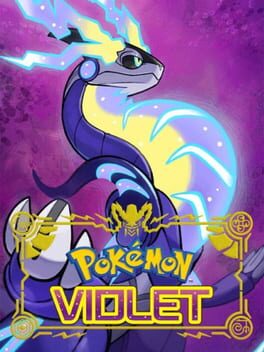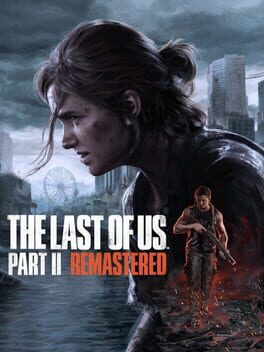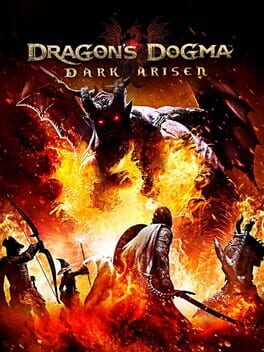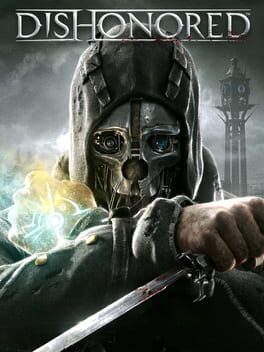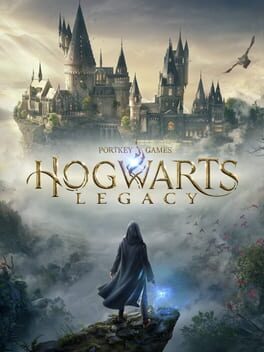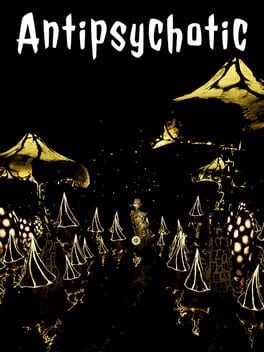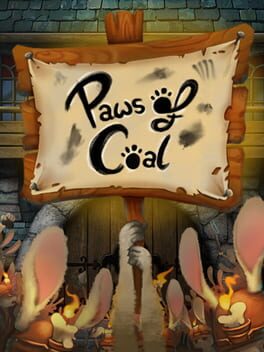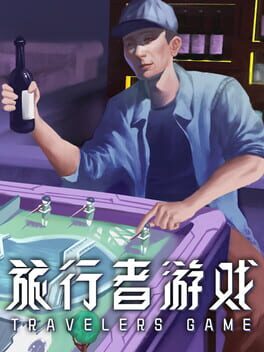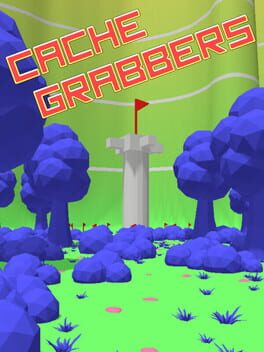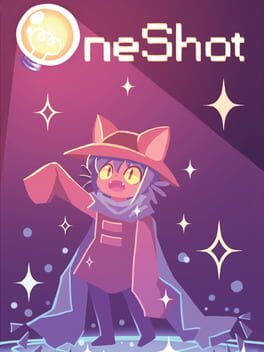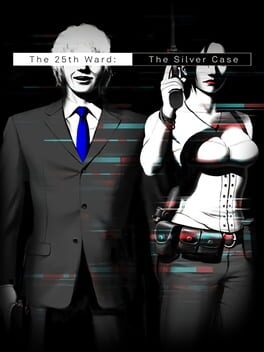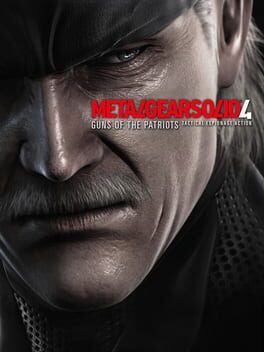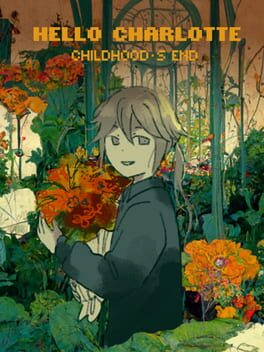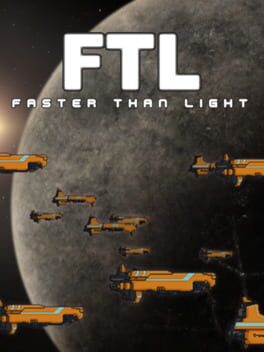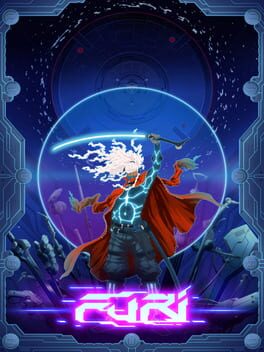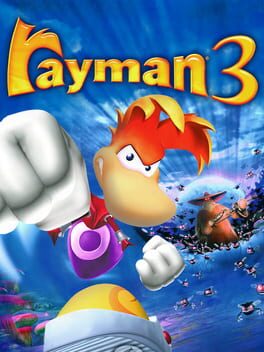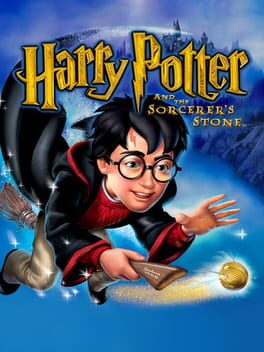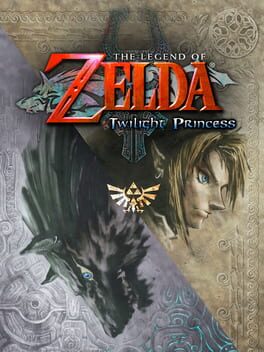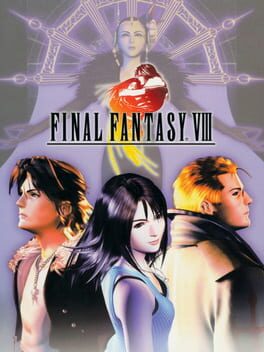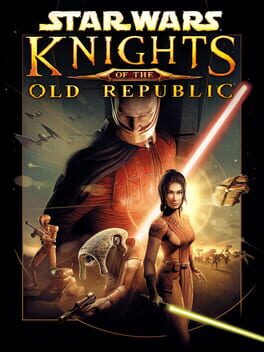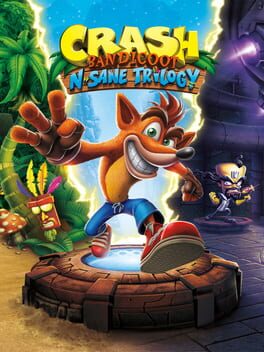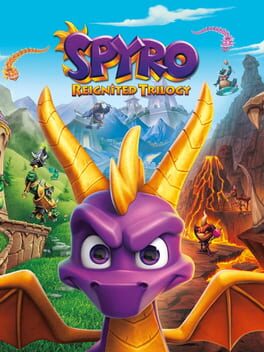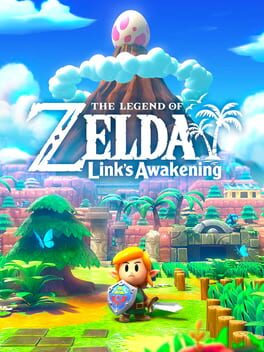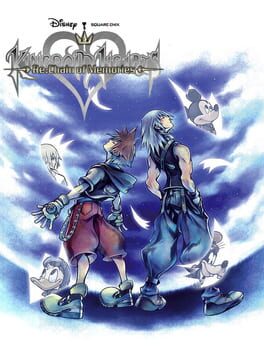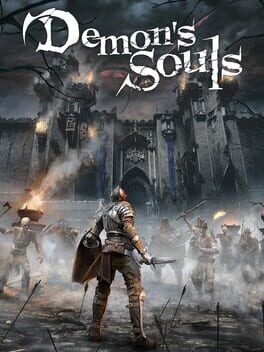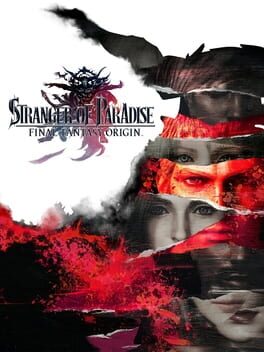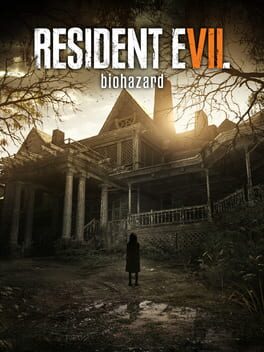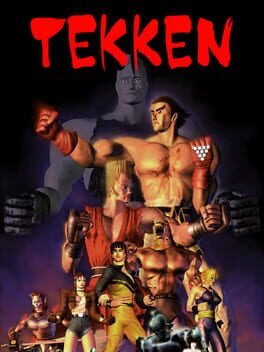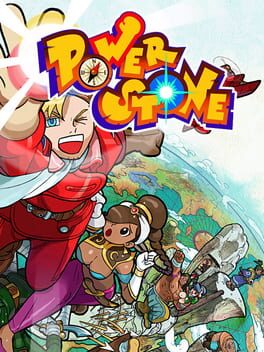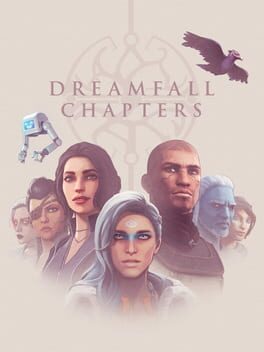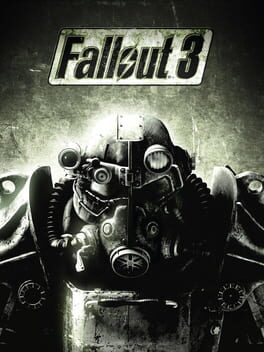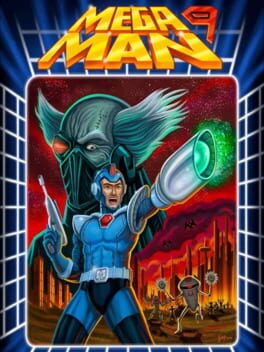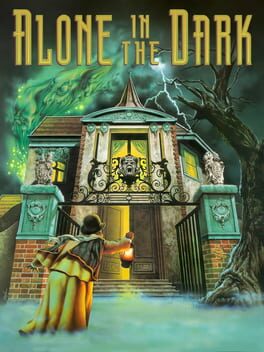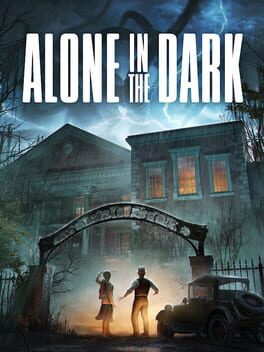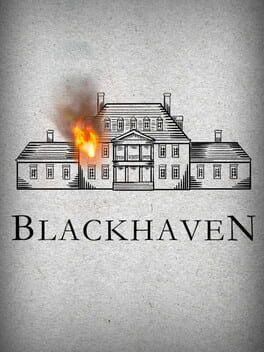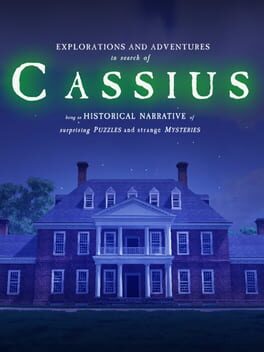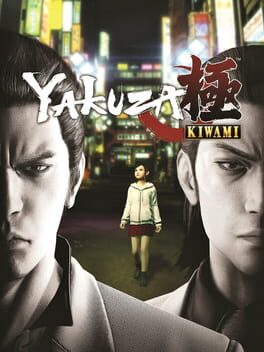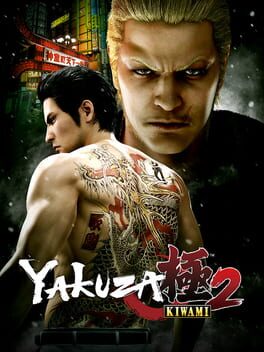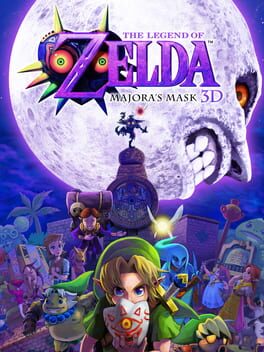AssignedKnives
40 reviews liked by AssignedKnives
Pokémon Violet
2022
It’s kinda incredible how Pokémon’s biggest evolution and arguably best step forward is held back by GameFreak’s limited dev time because of the Pokémon Company’s endless quest for brand syngery as they’d rather prioritize increasing yearly profit margins for putting out Sprigatito merch on time over having a game that doesn’t look somewhat crusty and on the verge of imploding at any given moment.
Platform: PlayStation 5
Date Started: January 31st, 2024
Date Finished: February 6th, 2024
Time Played: 16 Hours
"There was a sequel. Wasn't as good."
One of, if not the most important things about The Last of Us Part I is its characters. Not just the main focus on Joel and Ellie's incredible growing relationship and journey together throughout, but all of the supporting characters you meet along the way. Bill, Sam and Henry, Tess, Tommy and even David are incredibly impactful, memorable, well written characters that leave a lasting impression on both the player and the characters at each part of your adventure, helping them grow and bond. They are all compelling, and all play a great role in the story.
In The Last of Us Part II there are even more characters - some returning, most new. The returning cast are all fairly good - Ellie's journey, quest for revenge, anger, hate, transformation and brutality are all executed well, although her character feels completely devoid of what we already knew. Joel gets much less time, but what little we see of him is also great, every scene leaving a huge mark on the player and reminding you what could have been if the story took a better direction. Tommy, too, is brilliant, and easily one of the best characters in the game - I definitely wish he played a more prominent role - something I believe would have made this chosen story much stronger. Dina, Jesse, Lev, Yara and Manny, however, are all utterly unmemorable, bland, boring, uninteresting, utterly poor characters, none of them feeling real, most of them being irritating.
Abby is where things sort of take a massive step backwards, too, and where it gets a little muddy. Her motives are completely understandable, but, like how Dina drags down Ellie's sections, all of Abby's supporting cast make hers even more of a chore, too. She in and of herself is already an incredibly boring, dry character, though, so everyone around her just makes matters even worse.
While it isn't close to what I would have wanted from a sequel to The Last of Us as it strips away almost everything that made the first game a great time, I do still like the idea of this story in concept. In execution, however, it just isn't pulled off well whatsoever, and from what we know about writer and director Neil Druckmann's ambitions for the original game, and how Bruce Straley reigned him in and contributed the better aspects of The Last of Us, it feels to me as if that co-director's presence was sorely missed, and Druckmann just couldn't craft these memorable characters alone (or with new co-writer Haley Gross).
There is a lot of melodramatic, teeny style drama here all throughout, and it drags down both Ellie's potentially great segments and adds to the reasons why Abbys are far from ever being interesting. The moments where Ellie and Abby's stories overlap are great, and there are some outstanding moments scattered throughout the game, but by the second half they are very few and far between, and grand set pieces have no impact if I don't care about the characters in them.
On top of this, the non-linear timeline, which I also think is a good idea, is also one executed poorly. Because of the extreme length of Abbys section, the game feels like it completely loses track of the main story in favour of these filler side-quest moments with the new characters instead of fully focusing on what the player is invested in narratively, and as such completely lost me.
There are also just too many conveniences and changes to returning characters in the plot that are incredibly glaring and jarring and feel surprisingly glossed over and not well thought out at all.
The game-play and presentation, however, are aspects where I have less complaints. Everything feels incredibly fluid, from the gun-play to the stealth, although the melee can be a little janky, and everything looks ridiculously good, with insane attention to detail at every moment. This is one of if not the best looking and produced games I have ever played, such a shame it is then that other things pull the experience down so much so that I eventually resorted to running past enemies to get through the game quicker.
In the end, then, this is a profoundly disappointing game - one that has incredible moments, brilliant game-play and near unrivalled visuals, but all that is let down by its main draw, and the thing I care about the most - its story and characters. Nothing else can really make up for this, it is too hard to enjoy the game-play when you are in control of and surrounded by characters that bored me to tears, and when the game is hours and hours longer than it needed to be.
Date Started: January 31st, 2024
Date Finished: February 6th, 2024
Time Played: 16 Hours
"There was a sequel. Wasn't as good."
One of, if not the most important things about The Last of Us Part I is its characters. Not just the main focus on Joel and Ellie's incredible growing relationship and journey together throughout, but all of the supporting characters you meet along the way. Bill, Sam and Henry, Tess, Tommy and even David are incredibly impactful, memorable, well written characters that leave a lasting impression on both the player and the characters at each part of your adventure, helping them grow and bond. They are all compelling, and all play a great role in the story.
In The Last of Us Part II there are even more characters - some returning, most new. The returning cast are all fairly good - Ellie's journey, quest for revenge, anger, hate, transformation and brutality are all executed well, although her character feels completely devoid of what we already knew. Joel gets much less time, but what little we see of him is also great, every scene leaving a huge mark on the player and reminding you what could have been if the story took a better direction. Tommy, too, is brilliant, and easily one of the best characters in the game - I definitely wish he played a more prominent role - something I believe would have made this chosen story much stronger. Dina, Jesse, Lev, Yara and Manny, however, are all utterly unmemorable, bland, boring, uninteresting, utterly poor characters, none of them feeling real, most of them being irritating.
Abby is where things sort of take a massive step backwards, too, and where it gets a little muddy. Her motives are completely understandable, but, like how Dina drags down Ellie's sections, all of Abby's supporting cast make hers even more of a chore, too. She in and of herself is already an incredibly boring, dry character, though, so everyone around her just makes matters even worse.
While it isn't close to what I would have wanted from a sequel to The Last of Us as it strips away almost everything that made the first game a great time, I do still like the idea of this story in concept. In execution, however, it just isn't pulled off well whatsoever, and from what we know about writer and director Neil Druckmann's ambitions for the original game, and how Bruce Straley reigned him in and contributed the better aspects of The Last of Us, it feels to me as if that co-director's presence was sorely missed, and Druckmann just couldn't craft these memorable characters alone (or with new co-writer Haley Gross).
There is a lot of melodramatic, teeny style drama here all throughout, and it drags down both Ellie's potentially great segments and adds to the reasons why Abbys are far from ever being interesting. The moments where Ellie and Abby's stories overlap are great, and there are some outstanding moments scattered throughout the game, but by the second half they are very few and far between, and grand set pieces have no impact if I don't care about the characters in them.
On top of this, the non-linear timeline, which I also think is a good idea, is also one executed poorly. Because of the extreme length of Abbys section, the game feels like it completely loses track of the main story in favour of these filler side-quest moments with the new characters instead of fully focusing on what the player is invested in narratively, and as such completely lost me.
There are also just too many conveniences and changes to returning characters in the plot that are incredibly glaring and jarring and feel surprisingly glossed over and not well thought out at all.
The game-play and presentation, however, are aspects where I have less complaints. Everything feels incredibly fluid, from the gun-play to the stealth, although the melee can be a little janky, and everything looks ridiculously good, with insane attention to detail at every moment. This is one of if not the best looking and produced games I have ever played, such a shame it is then that other things pull the experience down so much so that I eventually resorted to running past enemies to get through the game quicker.
In the end, then, this is a profoundly disappointing game - one that has incredible moments, brilliant game-play and near unrivalled visuals, but all that is let down by its main draw, and the thing I care about the most - its story and characters. Nothing else can really make up for this, it is too hard to enjoy the game-play when you are in control of and surrounded by characters that bored me to tears, and when the game is hours and hours longer than it needed to be.
Final Fantasy XVI
2023
'Those great, beautiful ships, rocking silently on the calm waters, with their idle and wistful sails, are they not telling us in a silent language — when will we depart for happiness?'
– Charles Baudelaire, Fusées, VIII, 1887 (personal translation).
One of the most difficult issues in fantasy studies is to define its contours and, by extension, its relationship to reality. In her seminal study, Fantasy: The literature of subversion (1981), Rosemary Jackson points out that fantasy violates the conventions and rules of our reality and: 'threatens to subvert rules and conventions taken to be normative [and] disturb "rules" of artistic representation and literature’s reproduction of the "real"' [1]. The capacity for deviation that speculative fiction offers is both an opportunity and a danger. Jackson points out that this subversive potential does not mean that fantasy or the fantastic are genres that always aim for social progressivism. In fact, the overwhelming majority of the pulp tradition was steeped in racist, homophobic and misogynist tropes that exerted a lasting influence on fiction throughout the late twentieth century and to this day.
The misogynist issue in Western-style fantasy
Many authors hide behind these historical precedents to conceal a conservative discourse. The existence of multiple races allows for the perpetuation of social oppression, and while female characters have generally become more active in recent decades, they continue to fit into old-fashioned stereotypes [2]. The Final Fantasy series is part of this dynamic and has always oscillated between these major themes of fantasy fiction, notably by offering a regular comparison between magic and technological modernity, nature and industry, good and evil, humanity and divinity. These dichotomies are relatively common and allow the story to touch on issues such as capitalist exploitation and the use of natural resources. However, the representation of other topics remains disastrous: Final Fantasy XIV (2010) is especially characterised by deep-seated racism and sexism, the latter partially masked by the presence of strong female characters in positions of power.
It is hard to say whether these precautions were taken to appeal to a particular audience, but it is clear that Final Fantasy XVI ignores all these concerns and plunges into the most outrageous archaism, piling on misogynistic scenes wherever possible, supposedly justified by the harshness of European medieval society. Excuses of this kind obscure the real issues. The player follows the story of Clive Rosfield, drawn into a quest for revenge after the Phoenix Gate incident, which spells the end of the Duchy of Rosaria. Miraculously reunited with his childhood friend Jill Warrick, he joins Cid's group, determined to change the situation of the Bearers – magic-capable individuals enslaved across the continent. Final Fantasy XVI is therefore a tale of free will and independence, pitting the dark nature of the world against the purity of Cid and Clive's ideals.
To create this atmosphere, as well as the division between good and evil, the title makes extensive use of violence, sex and sexual violence as narrative drivers. Lenise Prater explains that Fiona McIntosh's Percheron trilogy (2005) constructs: 'a series of juxtapositions between good and evil [...] through the representation of sexual violence' [3]. The same processes are at work in Final Fantasy XVI, from the very first narrative arc of the adventure, where Benedikta is cast as the archetypal femme fatale, ready to use her body to manipulate her rivals: the character is constantly brought back to her status as a woman, and it is the threat of sexual violence that cements her development – Annabella is constructed in a similar way. Final Fantasy XVI revels in the dichotomy between whores and innocent virgins. Despite the Western aesthetic of the title, Jill is no more than a yamato nadeshiko who is constantly sidelined by the game. She mostly serves as a narrative device to advance the plot, through her multiple visits to the infirmary or because she is kidnapped by Clive's enemies. The title denies her any agency, and her nuanced fragility is only hinted at in a few sentences before being brushed aside: it takes almost thirty hours of gameplay before Clive explicitly asks her how she is, despite her constant concern for the protagonist's anxieties.
A case for centrism and laissez-faire
This conservative portrayal is echoed in the discourse on the Bearers. The game is moderately critical of slavery on the continent and fails to make it a structural issue for Clive, who always remains somewhat detached from the problem. This issue is structurally embedded in the way the player interacts with the world, as they are extremely passive in relation to the events portrayed in the story. While the player is aware of the political manipulations taking place in Storm, they cannot act on them directly; Clive is blindly thrown into the fray and the situation is simply resolved in a battle that depoliticises the social stakes. Similarly, the Seals donated by certain NPCs guarantee Clive's reputation in the community in a highly artificial way, removing any roughness from the interactions. Clive fights to free the Bearers because he inherits this mission from his father and Cid, but this task seems disembodied throughout the game.
Beyond the main quest, the side quests are particularly lacklustre and do little to deepen the world-building. Because they can be accessed at any point in the game, Final Fantasy XVI chooses to exclude companions from them. They simply disappear from the cutscenes and thus have no chance to react to the world around them. Since the intention is to establish Clive as an ideologically good, open and self-governing character, all side quests are resolved by Clive's ideological concessions or miraculous unifications in the face of artificially created danger, without the slightest contradiction from any of the other main characters. Only in the final stretch does someone point out Clive's hypocrisy and domineering power over Jill, but the scene is quickly swept away by the return of Gav, the comic relief of the group.
Final Fantasy XVI is more concerned with shocking, melodramatic or cathartic platitudes than with radical denunciations of inequality and oppression. Worse, these shocking scenes do not even make the world dynamic, so poor is the structure of the narrative. Two problems stand out. Firstly, the interweaving of high-intensity sequences with slower passages: instead of building up the world through genuine slice-of-life sequences, the game multiplies banalities that the player has already understood for several dozen hours. The temporality of the story is also incoherent. Clive seems to cross the continent in a matter of hours, while his rivals remain completely passive. The confrontation between the Sanbreque Empire and the Dhalmekian Republic is characterised by irrational stagnation and passivity, allowing Clive to strike unhindered. The Twins always remain static, despite long ellipses in time.
A hollow and meaningless experience
Perhaps Final Fantasy XVI should not be taken so literally, but rather accepted as the nekketsu it becomes in the second half of the game. Such an interpretation would be acceptable if the game did not take itself so seriously. However, as in Final Fantasy XIV, the writing wallows in a very uncomfortable theatrical heaviness – which the actors generally manage to save from disaster – as if clumsily mimicking the drama of Shakespeare's historical plays. However, Clive's disillusioned, self-deprecating, borderline comic character breaks up this fiction. Some characters work well, playing up their theatrical nature, such as Cid or Lord Byron, but they are quickly relegated to the background or an essentially comic role.
The shifts in tone and pacing detract from the development of the narrative, which cannot be saved by a few flashes of brilliance. The aetheric floods seem to have been imagined as a reflection of nuclear risks, highlighting the danger of Japan's post-Fukushima energy crutch, but in the end they are only used as a narrative expedient to create danger where the plot needs it. The pinnacle of dishonesty and disrespect for a title that centres its discourse on human free will lies in the choice of names for the NPC fillers. In the pure tradition of Final Fantasy XIV, they include puns and comical alliterations ('Broom-Bearer') that strip them of all substance and reduce them to ridicule. In the second half of the game, a little girl is introduced as a character of some narrative importance, but the title does not even bother to give her a name or address her living conditions.
Meanwhile, the action sequences prove to be particularly hollow. The choreography in the first few hours is quite ingenious, highlighting Clive's agility with complex movements and rather creative camera angles. As the title progresses, this aspect is abandoned in favour of fights that drag on and resort to nekketsu clichés. The duel against Titan lasts forty minutes and is a miserable succession of attacks around the stone tentacles. Final Fantasy XVI even has the audacity to end the battle not with the obvious cinematic climax, but with a dull and particularly unpleasant aerial sequence. Subsequent encounters also drag on for no apparent reason other than to demonstrate a genuine – if futile – mastery of the lightning engine.
Ergonomics, gameplay and fluidity
While Final Fantasy XVI boasts detailed environments at first glance, the facade quickly cracks. The early areas are indeed highly detailed, to the point of drowning the player in detail – navigating through the thick vegetation is quite difficult, forcing the player to use Torgal to progress – but the quality deteriorates as the game progresses. The dense environments disappear in favour of vast open areas that struggle to convey the majesty of the world. Although the cities visible on the horizon are beautiful backdrops, they fail to radiate materially onto their surroundings, which then become mere abstractions. Moreover, Clive's movement is extremely sluggish: even getting on his chocobo is an unpleasant task that constantly interrupts the fluidity of the action, while the player is condemned to an extraordinary passivity in order to get from one place to another.
In the Hideaway, this impression is reinforced by Clive's inability to sprint: in the second half of the game, getting to the backyard is a gruelling chore. The magic of this cocoon quickly vanishes, as the various characters keep repeating themselves and are only mediocrely animated. Despite the detailed scenery, the game borrows all its animations from Final Fantasy XIV, giving a very artificial tone to the discussions. The Hideaway is less a place where the player can comfortably catch up with their favourite NPCs, and more a burdensome obligation to access NPCs, side quests and the hunt board – requiring the player to physically go there to see the location of elite monsters, a design mistake that even Final Fantasy XIV avoided.
The enjoyment of the combat system is left to the player and their experience of other character-action games, but it is absurd that the player has to wait at least twenty hours to finally be given a modicum of flexibility in their attack options: Final Fantasy XVI justifies its unique protagonist with a deep combat system that encourages the creation of diverse builds, but this philosophy is only appropriate in a New Game+ where all powers are unlocked from the start. In a first playthrough, the player must suffer from an impressive slowness, to the point where the Story Mode becomes an obvious option. The title here echoes the recent problem of Shadowbringers (2019) and especially Endwalker (2021), which first designs its battles with the Extreme and Savage versions, before cutting out the most difficult sections for the Normal versions – the result is a sense of incompleteness that is particularly damaging when combined with the very slowly evolving combat system.
It is difficult to place Final Fantasy XVI in the landscape of modern Japanese video games, so awkward is it in every way. With the title still in its cycle of artificial marketing in preparation for the DLCs, one can only speculate as to the reasons for these failings. Perhaps the lack of coherence can be explained by the fractured development team working on two major games, and the highly eclectic nature of the directors brought together by Naoki Yoshida. His design philosophy is particularly well suited to an MMO, but Final Fantasy XVI suffers greatly from it: the endless succession of side quests involving the Hideaway characters just before the final battle is incomprehensible, as if the game had remembered that it needed to conclude. Hiroshi Takai and Kazutoyo Maehiro's narrative vision is a series of shocking, empty, meaningless scenes: players of Heavensward (2015) had the opportunity to suffer from Ysayle's portrayal, and it is surprising that Final Fantasy XVI does even worse, a standard-bearer for passive misogyny in modern fantasy. That Jill's theme becomes 'My Star' and denies her any agency in the game's final moments is particularly painful and aptly sums up the title.
__________
[1] Rosemary Jackson, Fantasy: The literature of subversion, Routledge, London, 2005 [1981], p. 14.
[2] On the topic, see for example Peter Bebergal (ed.), Appendix N: The Eldritch Roots Of Dungeons & Dragons, Strange Attractor Press, London, 2021. In the afterword, Ann VanderMeer discusses the conservative roots of pulp fantasy and of the historical TTRPG.
[3] Lenise Prater, 'Monstrous Fantasies: Reinforcing Rape Culture in Fiona McIntosh's Fantasy Novels', in Hecate, vol. 39, no. 1-2, 2014.
– Charles Baudelaire, Fusées, VIII, 1887 (personal translation).
One of the most difficult issues in fantasy studies is to define its contours and, by extension, its relationship to reality. In her seminal study, Fantasy: The literature of subversion (1981), Rosemary Jackson points out that fantasy violates the conventions and rules of our reality and: 'threatens to subvert rules and conventions taken to be normative [and] disturb "rules" of artistic representation and literature’s reproduction of the "real"' [1]. The capacity for deviation that speculative fiction offers is both an opportunity and a danger. Jackson points out that this subversive potential does not mean that fantasy or the fantastic are genres that always aim for social progressivism. In fact, the overwhelming majority of the pulp tradition was steeped in racist, homophobic and misogynist tropes that exerted a lasting influence on fiction throughout the late twentieth century and to this day.
The misogynist issue in Western-style fantasy
Many authors hide behind these historical precedents to conceal a conservative discourse. The existence of multiple races allows for the perpetuation of social oppression, and while female characters have generally become more active in recent decades, they continue to fit into old-fashioned stereotypes [2]. The Final Fantasy series is part of this dynamic and has always oscillated between these major themes of fantasy fiction, notably by offering a regular comparison between magic and technological modernity, nature and industry, good and evil, humanity and divinity. These dichotomies are relatively common and allow the story to touch on issues such as capitalist exploitation and the use of natural resources. However, the representation of other topics remains disastrous: Final Fantasy XIV (2010) is especially characterised by deep-seated racism and sexism, the latter partially masked by the presence of strong female characters in positions of power.
It is hard to say whether these precautions were taken to appeal to a particular audience, but it is clear that Final Fantasy XVI ignores all these concerns and plunges into the most outrageous archaism, piling on misogynistic scenes wherever possible, supposedly justified by the harshness of European medieval society. Excuses of this kind obscure the real issues. The player follows the story of Clive Rosfield, drawn into a quest for revenge after the Phoenix Gate incident, which spells the end of the Duchy of Rosaria. Miraculously reunited with his childhood friend Jill Warrick, he joins Cid's group, determined to change the situation of the Bearers – magic-capable individuals enslaved across the continent. Final Fantasy XVI is therefore a tale of free will and independence, pitting the dark nature of the world against the purity of Cid and Clive's ideals.
To create this atmosphere, as well as the division between good and evil, the title makes extensive use of violence, sex and sexual violence as narrative drivers. Lenise Prater explains that Fiona McIntosh's Percheron trilogy (2005) constructs: 'a series of juxtapositions between good and evil [...] through the representation of sexual violence' [3]. The same processes are at work in Final Fantasy XVI, from the very first narrative arc of the adventure, where Benedikta is cast as the archetypal femme fatale, ready to use her body to manipulate her rivals: the character is constantly brought back to her status as a woman, and it is the threat of sexual violence that cements her development – Annabella is constructed in a similar way. Final Fantasy XVI revels in the dichotomy between whores and innocent virgins. Despite the Western aesthetic of the title, Jill is no more than a yamato nadeshiko who is constantly sidelined by the game. She mostly serves as a narrative device to advance the plot, through her multiple visits to the infirmary or because she is kidnapped by Clive's enemies. The title denies her any agency, and her nuanced fragility is only hinted at in a few sentences before being brushed aside: it takes almost thirty hours of gameplay before Clive explicitly asks her how she is, despite her constant concern for the protagonist's anxieties.
A case for centrism and laissez-faire
This conservative portrayal is echoed in the discourse on the Bearers. The game is moderately critical of slavery on the continent and fails to make it a structural issue for Clive, who always remains somewhat detached from the problem. This issue is structurally embedded in the way the player interacts with the world, as they are extremely passive in relation to the events portrayed in the story. While the player is aware of the political manipulations taking place in Storm, they cannot act on them directly; Clive is blindly thrown into the fray and the situation is simply resolved in a battle that depoliticises the social stakes. Similarly, the Seals donated by certain NPCs guarantee Clive's reputation in the community in a highly artificial way, removing any roughness from the interactions. Clive fights to free the Bearers because he inherits this mission from his father and Cid, but this task seems disembodied throughout the game.
Beyond the main quest, the side quests are particularly lacklustre and do little to deepen the world-building. Because they can be accessed at any point in the game, Final Fantasy XVI chooses to exclude companions from them. They simply disappear from the cutscenes and thus have no chance to react to the world around them. Since the intention is to establish Clive as an ideologically good, open and self-governing character, all side quests are resolved by Clive's ideological concessions or miraculous unifications in the face of artificially created danger, without the slightest contradiction from any of the other main characters. Only in the final stretch does someone point out Clive's hypocrisy and domineering power over Jill, but the scene is quickly swept away by the return of Gav, the comic relief of the group.
Final Fantasy XVI is more concerned with shocking, melodramatic or cathartic platitudes than with radical denunciations of inequality and oppression. Worse, these shocking scenes do not even make the world dynamic, so poor is the structure of the narrative. Two problems stand out. Firstly, the interweaving of high-intensity sequences with slower passages: instead of building up the world through genuine slice-of-life sequences, the game multiplies banalities that the player has already understood for several dozen hours. The temporality of the story is also incoherent. Clive seems to cross the continent in a matter of hours, while his rivals remain completely passive. The confrontation between the Sanbreque Empire and the Dhalmekian Republic is characterised by irrational stagnation and passivity, allowing Clive to strike unhindered. The Twins always remain static, despite long ellipses in time.
A hollow and meaningless experience
Perhaps Final Fantasy XVI should not be taken so literally, but rather accepted as the nekketsu it becomes in the second half of the game. Such an interpretation would be acceptable if the game did not take itself so seriously. However, as in Final Fantasy XIV, the writing wallows in a very uncomfortable theatrical heaviness – which the actors generally manage to save from disaster – as if clumsily mimicking the drama of Shakespeare's historical plays. However, Clive's disillusioned, self-deprecating, borderline comic character breaks up this fiction. Some characters work well, playing up their theatrical nature, such as Cid or Lord Byron, but they are quickly relegated to the background or an essentially comic role.
The shifts in tone and pacing detract from the development of the narrative, which cannot be saved by a few flashes of brilliance. The aetheric floods seem to have been imagined as a reflection of nuclear risks, highlighting the danger of Japan's post-Fukushima energy crutch, but in the end they are only used as a narrative expedient to create danger where the plot needs it. The pinnacle of dishonesty and disrespect for a title that centres its discourse on human free will lies in the choice of names for the NPC fillers. In the pure tradition of Final Fantasy XIV, they include puns and comical alliterations ('Broom-Bearer') that strip them of all substance and reduce them to ridicule. In the second half of the game, a little girl is introduced as a character of some narrative importance, but the title does not even bother to give her a name or address her living conditions.
Meanwhile, the action sequences prove to be particularly hollow. The choreography in the first few hours is quite ingenious, highlighting Clive's agility with complex movements and rather creative camera angles. As the title progresses, this aspect is abandoned in favour of fights that drag on and resort to nekketsu clichés. The duel against Titan lasts forty minutes and is a miserable succession of attacks around the stone tentacles. Final Fantasy XVI even has the audacity to end the battle not with the obvious cinematic climax, but with a dull and particularly unpleasant aerial sequence. Subsequent encounters also drag on for no apparent reason other than to demonstrate a genuine – if futile – mastery of the lightning engine.
Ergonomics, gameplay and fluidity
While Final Fantasy XVI boasts detailed environments at first glance, the facade quickly cracks. The early areas are indeed highly detailed, to the point of drowning the player in detail – navigating through the thick vegetation is quite difficult, forcing the player to use Torgal to progress – but the quality deteriorates as the game progresses. The dense environments disappear in favour of vast open areas that struggle to convey the majesty of the world. Although the cities visible on the horizon are beautiful backdrops, they fail to radiate materially onto their surroundings, which then become mere abstractions. Moreover, Clive's movement is extremely sluggish: even getting on his chocobo is an unpleasant task that constantly interrupts the fluidity of the action, while the player is condemned to an extraordinary passivity in order to get from one place to another.
In the Hideaway, this impression is reinforced by Clive's inability to sprint: in the second half of the game, getting to the backyard is a gruelling chore. The magic of this cocoon quickly vanishes, as the various characters keep repeating themselves and are only mediocrely animated. Despite the detailed scenery, the game borrows all its animations from Final Fantasy XIV, giving a very artificial tone to the discussions. The Hideaway is less a place where the player can comfortably catch up with their favourite NPCs, and more a burdensome obligation to access NPCs, side quests and the hunt board – requiring the player to physically go there to see the location of elite monsters, a design mistake that even Final Fantasy XIV avoided.
The enjoyment of the combat system is left to the player and their experience of other character-action games, but it is absurd that the player has to wait at least twenty hours to finally be given a modicum of flexibility in their attack options: Final Fantasy XVI justifies its unique protagonist with a deep combat system that encourages the creation of diverse builds, but this philosophy is only appropriate in a New Game+ where all powers are unlocked from the start. In a first playthrough, the player must suffer from an impressive slowness, to the point where the Story Mode becomes an obvious option. The title here echoes the recent problem of Shadowbringers (2019) and especially Endwalker (2021), which first designs its battles with the Extreme and Savage versions, before cutting out the most difficult sections for the Normal versions – the result is a sense of incompleteness that is particularly damaging when combined with the very slowly evolving combat system.
It is difficult to place Final Fantasy XVI in the landscape of modern Japanese video games, so awkward is it in every way. With the title still in its cycle of artificial marketing in preparation for the DLCs, one can only speculate as to the reasons for these failings. Perhaps the lack of coherence can be explained by the fractured development team working on two major games, and the highly eclectic nature of the directors brought together by Naoki Yoshida. His design philosophy is particularly well suited to an MMO, but Final Fantasy XVI suffers greatly from it: the endless succession of side quests involving the Hideaway characters just before the final battle is incomprehensible, as if the game had remembered that it needed to conclude. Hiroshi Takai and Kazutoyo Maehiro's narrative vision is a series of shocking, empty, meaningless scenes: players of Heavensward (2015) had the opportunity to suffer from Ysayle's portrayal, and it is surprising that Final Fantasy XVI does even worse, a standard-bearer for passive misogyny in modern fantasy. That Jill's theme becomes 'My Star' and denies her any agency in the game's final moments is particularly painful and aptly sums up the title.
__________
[1] Rosemary Jackson, Fantasy: The literature of subversion, Routledge, London, 2005 [1981], p. 14.
[2] On the topic, see for example Peter Bebergal (ed.), Appendix N: The Eldritch Roots Of Dungeons & Dragons, Strange Attractor Press, London, 2021. In the afterword, Ann VanderMeer discusses the conservative roots of pulp fantasy and of the historical TTRPG.
[3] Lenise Prater, 'Monstrous Fantasies: Reinforcing Rape Culture in Fiona McIntosh's Fantasy Novels', in Hecate, vol. 39, no. 1-2, 2014.
This is the only game I've ever played during which I've thought to myself "this is probably what it would be like to fight a dragon in real life."
From that thought, a lot can be gleaned about Dragon's Dogma. The animations and behaviours of its fictional fantasy creatures are remarkably lifelike, which bolsters its already strong immersive qualities, but the combat is arguably where it shines the most - and not just because its bows feel like semi-automatic rifles or because Arc of Deliverance is the single most satisfying move to use in any game ever made. Where a lesser game would typically have you fight a giant monster by whittling away at its ankles ad nauseam or some other comparably restrictive method, Dragon's Dogma lets you (among other things) climb onto it, knock it over, stun it, break off or cripple certain body parts, douse it in oil & light it on fire, lure it into a disadvantageous spot or environmental hazard, bring it crashing down to the ground while it's flying, send it flying through the air, freeze it, parry it, or jump off of it to reach a place you otherwise couldn't. It's like a power metal album cover come to life, with a soundtrack to match. It’s chaotic, it’s dynamic, and it’s absolutely drowning in techniques to try out.
That alone would be enough to set Dragon's Dogma above most other real-time combat systems, but what takes it to the next level is the genius pawn system. Few games offer satisfaction on the level of figuring out a golden tactic against a particularly troublesome enemy, watching your pawns become better and better at its execution over time, and being rewarded by other players for renting out your home-made killing machine to them. My mind was blown the first time I realised my pawn had learned to throw explosive barrels specifically when a tough enemy is near a ledge to kill them instantly, and almost a full decade later they continue to surprise with behaviours like this. There’s plenty else to enjoy about Dragon’s Dogma’s combat system, like the enormous playstyle diversity afforded by its classes or the chunky hitstop that provides great feedback on every attack, but it’s far from the only thing the game offers.
For one thing, Dragon’s Dogma sells the feeling of adventure very well. While not quite to the extent of in something like Breath of the Wild, you really do have to legitimately think about how to get from one place to another. Should I risk trying to clamber up that ledge or is it more practical to take the long way around, even if that means meeting more monsters? What time of day should I start my journey, or will it be short enough that I shouldn’t have to worry about all the beasties coming out when night falls? If night falls, do I have enough fuel for my lantern and is my character tall enough that it won't be extinguished by forging through bodies of water? You find yourself asking all these questions as you make your way to distant landmarks which you weren’t initially even sure if you could physically get to, which I think is enough to make the open world a net positive overall despite its blatant and unfortunate unfinished-ness. It helps that pretty much all of the dungeons in both Gransys and Bitterblack are rewarding to explore, with lots of goodies to find in hidden alternate pathways and enemy layouts which get dramatically overhauled in the post-game.
Beyond that, I’ll always stick up for the story of Dragon’s Dogma. Bingo Morihashi is seemingly cursed to always deliver well thought-out, thematically solid stories that everyone writes off as crap for some reason. Even if contextualising new game plus into it wasn’t rad as hell (and it is), the intentionally antiquated dialogue gives it so much character and it conveys such an immense, ambitious sense of progression in terms of scale. And speaking of scales (literally), Grigori is an all-timer in the realm of video game antagonists. Coupled with David Lodge’s masterful delivery, every line of his gives him such presence. He’s everything a dragon should be according to their traditional cultural depictions; not just huge, imposing and a fierce fighter, but also really intelligent and reserved to the point where it's not easy to classify him as a 'villain.' The fight against him having both style and substance in spades is just the cherry on top.
Daimon is also compelling, and his segment of the game is probably what’ll keep you coming back for more. Bitterblack Isle’s not just a wonderful, almost endlessly replayable DLC that marks a gold-standard for content density, it’s also a tantalising glimpse into Hideaki Itsuno’s full vision for Dragon’s Dogma. It was meant to have dozens of Bitterblack equivalents scattered throughout the world before its development was cut short, not the least of which included being able to travel to the moon and a massive MMO-like tower in which players could trade with one another and glimpse at each other’s worlds, endlessly stacked on top of each other. Had Itsuno and his team been allowed to carry out that vision, I’ve little doubt that Dragon’s Dogma would probably be my favourite game of all time. As it stands, it’s close enough already – all I think a hypothetical sequel would really need is for its open world to be more densely packed with content and a real-time healing system (outside of hotkeys and spells), like that of Nioh or a certain other ARPG series from the past decade or so that I hear is pretty popular.
It’s well known now that Capcom presented Itsuno with the choice to either develop Devil May Cry 5 or Dragon’s Dogma 2 a few years ago. Given the freedom that Capcom granted to him during the making of DMC5 and his recent teasing that his elusive new project is making good progress, I can’t help but have hope for the first time since release that aught is on the horizon. A Dragon’s Dogma sequel wouldn’t just be nice to see, it’d mark a victory for any and all game creators who want to see their vision fully realised.
From that thought, a lot can be gleaned about Dragon's Dogma. The animations and behaviours of its fictional fantasy creatures are remarkably lifelike, which bolsters its already strong immersive qualities, but the combat is arguably where it shines the most - and not just because its bows feel like semi-automatic rifles or because Arc of Deliverance is the single most satisfying move to use in any game ever made. Where a lesser game would typically have you fight a giant monster by whittling away at its ankles ad nauseam or some other comparably restrictive method, Dragon's Dogma lets you (among other things) climb onto it, knock it over, stun it, break off or cripple certain body parts, douse it in oil & light it on fire, lure it into a disadvantageous spot or environmental hazard, bring it crashing down to the ground while it's flying, send it flying through the air, freeze it, parry it, or jump off of it to reach a place you otherwise couldn't. It's like a power metal album cover come to life, with a soundtrack to match. It’s chaotic, it’s dynamic, and it’s absolutely drowning in techniques to try out.
That alone would be enough to set Dragon's Dogma above most other real-time combat systems, but what takes it to the next level is the genius pawn system. Few games offer satisfaction on the level of figuring out a golden tactic against a particularly troublesome enemy, watching your pawns become better and better at its execution over time, and being rewarded by other players for renting out your home-made killing machine to them. My mind was blown the first time I realised my pawn had learned to throw explosive barrels specifically when a tough enemy is near a ledge to kill them instantly, and almost a full decade later they continue to surprise with behaviours like this. There’s plenty else to enjoy about Dragon’s Dogma’s combat system, like the enormous playstyle diversity afforded by its classes or the chunky hitstop that provides great feedback on every attack, but it’s far from the only thing the game offers.
For one thing, Dragon’s Dogma sells the feeling of adventure very well. While not quite to the extent of in something like Breath of the Wild, you really do have to legitimately think about how to get from one place to another. Should I risk trying to clamber up that ledge or is it more practical to take the long way around, even if that means meeting more monsters? What time of day should I start my journey, or will it be short enough that I shouldn’t have to worry about all the beasties coming out when night falls? If night falls, do I have enough fuel for my lantern and is my character tall enough that it won't be extinguished by forging through bodies of water? You find yourself asking all these questions as you make your way to distant landmarks which you weren’t initially even sure if you could physically get to, which I think is enough to make the open world a net positive overall despite its blatant and unfortunate unfinished-ness. It helps that pretty much all of the dungeons in both Gransys and Bitterblack are rewarding to explore, with lots of goodies to find in hidden alternate pathways and enemy layouts which get dramatically overhauled in the post-game.
Beyond that, I’ll always stick up for the story of Dragon’s Dogma. Bingo Morihashi is seemingly cursed to always deliver well thought-out, thematically solid stories that everyone writes off as crap for some reason. Even if contextualising new game plus into it wasn’t rad as hell (and it is), the intentionally antiquated dialogue gives it so much character and it conveys such an immense, ambitious sense of progression in terms of scale. And speaking of scales (literally), Grigori is an all-timer in the realm of video game antagonists. Coupled with David Lodge’s masterful delivery, every line of his gives him such presence. He’s everything a dragon should be according to their traditional cultural depictions; not just huge, imposing and a fierce fighter, but also really intelligent and reserved to the point where it's not easy to classify him as a 'villain.' The fight against him having both style and substance in spades is just the cherry on top.
Daimon is also compelling, and his segment of the game is probably what’ll keep you coming back for more. Bitterblack Isle’s not just a wonderful, almost endlessly replayable DLC that marks a gold-standard for content density, it’s also a tantalising glimpse into Hideaki Itsuno’s full vision for Dragon’s Dogma. It was meant to have dozens of Bitterblack equivalents scattered throughout the world before its development was cut short, not the least of which included being able to travel to the moon and a massive MMO-like tower in which players could trade with one another and glimpse at each other’s worlds, endlessly stacked on top of each other. Had Itsuno and his team been allowed to carry out that vision, I’ve little doubt that Dragon’s Dogma would probably be my favourite game of all time. As it stands, it’s close enough already – all I think a hypothetical sequel would really need is for its open world to be more densely packed with content and a real-time healing system (outside of hotkeys and spells), like that of Nioh or a certain other ARPG series from the past decade or so that I hear is pretty popular.
It’s well known now that Capcom presented Itsuno with the choice to either develop Devil May Cry 5 or Dragon’s Dogma 2 a few years ago. Given the freedom that Capcom granted to him during the making of DMC5 and his recent teasing that his elusive new project is making good progress, I can’t help but have hope for the first time since release that aught is on the horizon. A Dragon’s Dogma sequel wouldn’t just be nice to see, it’d mark a victory for any and all game creators who want to see their vision fully realised.
Dishonored
2012
They don't make games like Dishonored anymore, do they?
Arkane Studios' defining title was always a remarkably creative piece of gaming greatness. It was one of the first games in a short-lived (yet still fantastic) revival of the immersive sim family of games. It was a strong addition to the stealth genre, and a rare new original property that managed to both stand out and be rewarded for its accomplishments. And aside from its sequels, there's still isn't anything else quite like it nowadays.
Dishonored has a lot of things going for it, most notably its art direction and setting. Dunwall is a memorable backdrop to the game's events and levels, brought to decaying life with its muted color scheme, Victorian-era architecture and a surprisingly strong combination of period piece, steampunk and dark fantasy imagery. While far from a horror game, Dishonored successfully fills Dunwall's crumbling society and plague-infested threats with never-ending and oppressive dread. And heartbreak, the more you explore the tragic decline of a once-powerful cultural and technological center.
Dunwall is a horrible place to live in, but a fantastic playground for its greatest assassin. The various locations Corvo has to get through during his missions are impeccably designed with multiple routes and options to experiment with and explore. The maps are not outrageously big, instead focusing on carefully-placed alternate paths, secrets, side objectives and additional methods that make you feel clever or sneaky if you find and use them. There is a great, elaborate verticality to each stage, allowing Corvo considerable amounts of freedom to find the perfect spots for takedowns and preparations.
As every good stealth game, Dishonored offers a very useful set of tools at Corvo's disposal. Corvo has a sword, a crossbow with various bolt types, a gun and even mines and grenades for good measure. While his arsenal does skew a little too much toward more violent solutions, it still offers non-lethal options such as a choking takedown and sleep darts. All in all, there is a lot of thought put into maintaining the ability to both go as violently as one pleases, but also spare even your assassination targets from certain death. And of course, courtesy of Dunwall's mythical godlike-slash-diabolical Outsider, Corvo gets a slew of cool superpowers.
The most notable of those powers is Blink, which grants Corvo teleportation. But there are even more powers to unlock and upgrade, like time manipulation and even rat plague, and assuming you have the mana for it, you can use a lot of them in quick succession for your ends or amusement. It's also balanced pretty well, with the more potent and complex abilities demanding more mana, and the game is kind enough to replenish your mana meter with spare elixirs whenever you try to use some of those more energy-consuming feats.
Interestingly, the actual combat system is also fairly robust. There is a strong emphasis on parrying, and enemies are also smart enough to know when to counter your sword, pushing you to time your attacks accordingly. There is some clumsiness to it, but it's more than serviceable and functional enough to be a valid option to utilize from start to finish.
So, the art, world, level design and gameplay are all great. I guess if there's any notable issue with Dishonored is that it's narrative and characters largely fail to do Dunwall's fascinating history and culture much-deserved justice. They're pretty standard-fare as far as the genre goes. There are some fun standouts like the sleazy-yet-honorable Slackjaw, the proud and guilt-ridden assassin Daud and the eccentric and philosophical Sokolov, but for the most part, both the allies and villains you meet across the way are there to fill roles, little more. This also goes to the Outsider who is a rather generic otherworldly benefactor, and Corvo himself, who is merely the player's avatar.
There is also this whole binary morality thing like we've seen in Bioshock and Infamous. It's pretty boring and limiting, but eh, nothing deal-breaking.
I do want to point out that despite the story's banality, the world is still very interesting and there are a lot of background bits to enrich the narrative. And Arkane's animators also did a great job in little bodily expressions to convey better emotion than what the dialogue could offer. Even Corvo - his little weapon swirl whenever he takes out or puts back his gear is a nice little demonstration of his skill and confidence. And while a rather contested point for some, I generally like the character designs. Yes, they can get rather ugly or disheveled, but this feels like a deliberate choice through and through, and even years after its original release, it's still refreshing to see a major AAA game rejecting conventional character designs for something so crude, yet stylized and believable at the same time.
It's not a particularly long game, but this only enhances Dishonored. This is game built for multiple playthroughs with so many scenarios to play out, and its true strength as a versatile slice of stealth-action can be seen as it adapts itself to the player's whims.
Excellent sound design completes an extremely strong package. The voice acting can be a little wooden but it does its job well enough, and every object and footstep can be clearly heard both and used both for advantage and disadvantage.
Dishonored was and remains a triumph of game design. It boasts one of the coolest settings in the medium and despite a thin narrative it's thriving with a personality of its own that both honors its spiritual predecessors such as Thief and System Shock, and modernizes their ideas for new generations. It's a reminder that AAA games can be more than just tedious mechanical kitchen sink, and even a decade later, I hope more studios will get the chance to create more unique, memorable games like this.
Arkane Studios' defining title was always a remarkably creative piece of gaming greatness. It was one of the first games in a short-lived (yet still fantastic) revival of the immersive sim family of games. It was a strong addition to the stealth genre, and a rare new original property that managed to both stand out and be rewarded for its accomplishments. And aside from its sequels, there's still isn't anything else quite like it nowadays.
Dishonored has a lot of things going for it, most notably its art direction and setting. Dunwall is a memorable backdrop to the game's events and levels, brought to decaying life with its muted color scheme, Victorian-era architecture and a surprisingly strong combination of period piece, steampunk and dark fantasy imagery. While far from a horror game, Dishonored successfully fills Dunwall's crumbling society and plague-infested threats with never-ending and oppressive dread. And heartbreak, the more you explore the tragic decline of a once-powerful cultural and technological center.
Dunwall is a horrible place to live in, but a fantastic playground for its greatest assassin. The various locations Corvo has to get through during his missions are impeccably designed with multiple routes and options to experiment with and explore. The maps are not outrageously big, instead focusing on carefully-placed alternate paths, secrets, side objectives and additional methods that make you feel clever or sneaky if you find and use them. There is a great, elaborate verticality to each stage, allowing Corvo considerable amounts of freedom to find the perfect spots for takedowns and preparations.
As every good stealth game, Dishonored offers a very useful set of tools at Corvo's disposal. Corvo has a sword, a crossbow with various bolt types, a gun and even mines and grenades for good measure. While his arsenal does skew a little too much toward more violent solutions, it still offers non-lethal options such as a choking takedown and sleep darts. All in all, there is a lot of thought put into maintaining the ability to both go as violently as one pleases, but also spare even your assassination targets from certain death. And of course, courtesy of Dunwall's mythical godlike-slash-diabolical Outsider, Corvo gets a slew of cool superpowers.
The most notable of those powers is Blink, which grants Corvo teleportation. But there are even more powers to unlock and upgrade, like time manipulation and even rat plague, and assuming you have the mana for it, you can use a lot of them in quick succession for your ends or amusement. It's also balanced pretty well, with the more potent and complex abilities demanding more mana, and the game is kind enough to replenish your mana meter with spare elixirs whenever you try to use some of those more energy-consuming feats.
Interestingly, the actual combat system is also fairly robust. There is a strong emphasis on parrying, and enemies are also smart enough to know when to counter your sword, pushing you to time your attacks accordingly. There is some clumsiness to it, but it's more than serviceable and functional enough to be a valid option to utilize from start to finish.
So, the art, world, level design and gameplay are all great. I guess if there's any notable issue with Dishonored is that it's narrative and characters largely fail to do Dunwall's fascinating history and culture much-deserved justice. They're pretty standard-fare as far as the genre goes. There are some fun standouts like the sleazy-yet-honorable Slackjaw, the proud and guilt-ridden assassin Daud and the eccentric and philosophical Sokolov, but for the most part, both the allies and villains you meet across the way are there to fill roles, little more. This also goes to the Outsider who is a rather generic otherworldly benefactor, and Corvo himself, who is merely the player's avatar.
There is also this whole binary morality thing like we've seen in Bioshock and Infamous. It's pretty boring and limiting, but eh, nothing deal-breaking.
I do want to point out that despite the story's banality, the world is still very interesting and there are a lot of background bits to enrich the narrative. And Arkane's animators also did a great job in little bodily expressions to convey better emotion than what the dialogue could offer. Even Corvo - his little weapon swirl whenever he takes out or puts back his gear is a nice little demonstration of his skill and confidence. And while a rather contested point for some, I generally like the character designs. Yes, they can get rather ugly or disheveled, but this feels like a deliberate choice through and through, and even years after its original release, it's still refreshing to see a major AAA game rejecting conventional character designs for something so crude, yet stylized and believable at the same time.
It's not a particularly long game, but this only enhances Dishonored. This is game built for multiple playthroughs with so many scenarios to play out, and its true strength as a versatile slice of stealth-action can be seen as it adapts itself to the player's whims.
Excellent sound design completes an extremely strong package. The voice acting can be a little wooden but it does its job well enough, and every object and footstep can be clearly heard both and used both for advantage and disadvantage.
Dishonored was and remains a triumph of game design. It boasts one of the coolest settings in the medium and despite a thin narrative it's thriving with a personality of its own that both honors its spiritual predecessors such as Thief and System Shock, and modernizes their ideas for new generations. It's a reminder that AAA games can be more than just tedious mechanical kitchen sink, and even a decade later, I hope more studios will get the chance to create more unique, memorable games like this.
Hogwarts Legacy
2023
haven’t played this game and i really don’t plan to but I do think it’s deeply hilarious that upon this game’s release defenders of the game’s prominent antisemitic undertones and Rowling’s continued deranged behaviour called this a GOTY candidate and a phenomenal game only for it to not get nominated a single time at the game awards or the golden joysticks. get fucked losers
Final Fantasy XVI
2023
Baldur's Gate 3
2020
Starfield
2023
This game lets me walk around looking out the windows of and meticulously hand-placing ornaments throughout a homemade, supersized approximation of an interceptor from Homeworld that I built for myself and my posh, English, spatially challenged Judge Anderson cosplayer wife to go dungeon diving in, and you’re telling me there are people who don’t enjoy it?
What’s as striking as this realisation is how much better Starfield feels to fundamentally move around in than Bethesda’s prior titles, especially in third person. Your character shifts their weight and takes a balancing step when moving from one direction to the opposite, the addition of mantling up ledges means where you can or can’t go’s significantly less ambiguous and a hefty degree of animation blending makes their transitioning between states more natural-looking. Beyond making it so that your character now actually feels like part of the world they’re in instead of indifferently gliding over it as in Fallout 3 and New Vegas, this has some positive knock-on effects in terms of environmental design.
Oblivion had its acrobatics and Fallout 4 its jetpack, but these largely weren’t able to factor into how you traversed dungeons since there had to be concessions for the inevitability that not every player would have them. In contrast, Starfield’s boost packs being practically universal alongside planetary modifiers means it can afford to get more creative in this respect. This was apparent even early on when I dropped into a cave on a low-gravity planet and had to get through it by jumping between a series of distant platforms, varying my boost timing to reach some of the taller ones like I was playing Jak & Daxter or something. Another particularly cool one let me float out of the roof of an initially closed hangar after a pirate ship arrived to give its inhabitants some backup, which I could later land my own ship inside after befriending those same pirates. Others still let me circumvent enemy encounters by way of boosting up to an overhead vent, something I might’ve missed if I were playing Starfield like one of Bethesda’s less vertical titles and never looked above me, or more colourfully via shifting between dimensions akin to that one level from Titanfall 2. The setting’s also a great help in terms of making shortcuts through these areas less conspicuous – emergency vents you have to break the seals of or imposing, computerised gates are a more natural fit for this kind of thing than what felt like every other ancient Nordic tomb having a not-so-secret collapsible door.
The semi-procedurally generated nature of Starfield’s planets means there’s always a risk of some of these places losing their lustre through repetition, but are two factors mitigating this. One, there are also no instances of Daggerfall’s ambitious but malevolently complicated RNG hellscapes and two, planets’ environmental conditions go at least some way towards keeping things varied; you’re probably not going to approach a multistorey Ecliptic tower on a nigh-zero G planet the same way you will on one where your feet barely leave the ground, for example. I’m inclined to chalk this up as a net positive partially for that reason and also because it creates a sense of not knowing how you’ll deal with what’s on the horizon even if you can eventually predict it, which is notably beneficial whenever everything’s reshuffled in a new game plus that’s conceptually reminiscent of and similarly sick as Dragon’s Dogma’s. Especially impressive was the fact that, as far as I can recall, I didn’t encounter the same alien wildlife on any two planets except when there was an in-universe explanation for it.
Some may find it dry that Starfield relegates aliens to fauna, but I find it refreshing if anything. A utilitarian focus purely on humanity, our place in the universe and what we ought to do with all that spess out there seem strangely underexplored ideas for how many sci-fi games there are, especially considering how naturally these lend themselves to RPGs specifically. Antagonists bicker over egoism versus altruism, quests commonly pose questions about how far venturing into the unknown is too far, balances of power can be tipped in situations as petty as a dispute between two local shop owners or as grand as instigating conflicts between galaxy-spanning factions, there’s always some trepidation in not knowing whether another spaceship is about to shake you down or treat you to a folk song, etc. Within the limitations of a game, it does quite a sound job of encapsulating what an eclectic bunch we are without being needlessly pessimistic about it.
As the above suggests, I don’t think Starfield’s writing particularly needs defending, in part because it’d do everyone some credit to recognise that writing in RPGs isn’t constrained to just dialogue boxes or cutscenes reflecting the outcomes of your pre-programmed “choices.” Coming across scenes like this tucked away in the collapsed shaft of an abandoned NASA facility, or spacer bases having credstiks strewn about where office appliances ought to be, gets the gears turning in my head as much as or more than any flowery bouts of exposition. In Todd Howard’s interview with Lex Fridman, he mentioned that Bethesda’s got a team specifically for arranging miscellaneous objects throughout their worlds in a way that makes them feel lived-in; although big-brained, standards-having gamers like you and me might scoff in disbelief when we trek outside our bubble and remember that Fallout 3’s not only generally very well liked but also won awards for its storytelling, it becomes easier to wrap your head around when you realise they’ve always been and continue to be ace at this.
An understated but crucial strength of all of these games which accentuates that’s also been expanded upon: Starfield lets you rotate and throw such objects with varying force in addition to being able to pick up and carry them as before. It’s got practical applications (e.g. chucking then shooting hazardous canisters), but to me its real importance is building upon an avenue of the kind of roleplaying that’s essentially unique to this developer, as well as a reason why I don’t understand what I’m supposed to be comparing it to, beyond the vaguest possible descriptors, when I read that it’s allegedly “dated.” Flipping a bucket and sticking it over Vasco’s head, orienting an object into a shopkeeper’s line of sight to prevent them from witnessing theft or otherwise messing about with physics are the kinds of things that I myself might actually do for kicks if I were really in my character’s shoes – I’m not actually a bug-themed, tanto-wielding sentai hero with a suspiciously large and well-organised stockpile of stolen food in his ship’s storage room, but the agency this one mechanic affords goes such a long way toward breaking down the barrier between character and player regardless that you could’ve fooled me.
Player agency falters a bit in other aspects like the abundance of essential NPCs, but this and occasionally finicky menus notwithstanding, I’m unsure which metrics I’m supposed to be gauging to determine that Starfield isn’t probably the best iteration of this formula in more ways than not. There’s not much to disparage here that couldn’t also be said of all its siblings ⁿᵒ ⁿᵉʷ ᵛᵉᵍᵃˢ ⁱˢ ʳᵉᵃˡˡʸ ⁿᵒᵗ ᵗʰᵃᵗ ᵈⁱᶠᶠᵉʳᵉⁿᵗ, except they weren’t counterweighted by the benefits of combat I don’t actively want to avoid whenever possible, the novelty of being able to divert power to different systems in a spaceship or a main quest climax which made me genuinely think about what I’d do in that scenario among other things. Catch me revving up the engines of the Hiigaran Beryl for another several dozen hours hereafter.
What’s as striking as this realisation is how much better Starfield feels to fundamentally move around in than Bethesda’s prior titles, especially in third person. Your character shifts their weight and takes a balancing step when moving from one direction to the opposite, the addition of mantling up ledges means where you can or can’t go’s significantly less ambiguous and a hefty degree of animation blending makes their transitioning between states more natural-looking. Beyond making it so that your character now actually feels like part of the world they’re in instead of indifferently gliding over it as in Fallout 3 and New Vegas, this has some positive knock-on effects in terms of environmental design.
Oblivion had its acrobatics and Fallout 4 its jetpack, but these largely weren’t able to factor into how you traversed dungeons since there had to be concessions for the inevitability that not every player would have them. In contrast, Starfield’s boost packs being practically universal alongside planetary modifiers means it can afford to get more creative in this respect. This was apparent even early on when I dropped into a cave on a low-gravity planet and had to get through it by jumping between a series of distant platforms, varying my boost timing to reach some of the taller ones like I was playing Jak & Daxter or something. Another particularly cool one let me float out of the roof of an initially closed hangar after a pirate ship arrived to give its inhabitants some backup, which I could later land my own ship inside after befriending those same pirates. Others still let me circumvent enemy encounters by way of boosting up to an overhead vent, something I might’ve missed if I were playing Starfield like one of Bethesda’s less vertical titles and never looked above me, or more colourfully via shifting between dimensions akin to that one level from Titanfall 2. The setting’s also a great help in terms of making shortcuts through these areas less conspicuous – emergency vents you have to break the seals of or imposing, computerised gates are a more natural fit for this kind of thing than what felt like every other ancient Nordic tomb having a not-so-secret collapsible door.
The semi-procedurally generated nature of Starfield’s planets means there’s always a risk of some of these places losing their lustre through repetition, but are two factors mitigating this. One, there are also no instances of Daggerfall’s ambitious but malevolently complicated RNG hellscapes and two, planets’ environmental conditions go at least some way towards keeping things varied; you’re probably not going to approach a multistorey Ecliptic tower on a nigh-zero G planet the same way you will on one where your feet barely leave the ground, for example. I’m inclined to chalk this up as a net positive partially for that reason and also because it creates a sense of not knowing how you’ll deal with what’s on the horizon even if you can eventually predict it, which is notably beneficial whenever everything’s reshuffled in a new game plus that’s conceptually reminiscent of and similarly sick as Dragon’s Dogma’s. Especially impressive was the fact that, as far as I can recall, I didn’t encounter the same alien wildlife on any two planets except when there was an in-universe explanation for it.
Some may find it dry that Starfield relegates aliens to fauna, but I find it refreshing if anything. A utilitarian focus purely on humanity, our place in the universe and what we ought to do with all that spess out there seem strangely underexplored ideas for how many sci-fi games there are, especially considering how naturally these lend themselves to RPGs specifically. Antagonists bicker over egoism versus altruism, quests commonly pose questions about how far venturing into the unknown is too far, balances of power can be tipped in situations as petty as a dispute between two local shop owners or as grand as instigating conflicts between galaxy-spanning factions, there’s always some trepidation in not knowing whether another spaceship is about to shake you down or treat you to a folk song, etc. Within the limitations of a game, it does quite a sound job of encapsulating what an eclectic bunch we are without being needlessly pessimistic about it.
As the above suggests, I don’t think Starfield’s writing particularly needs defending, in part because it’d do everyone some credit to recognise that writing in RPGs isn’t constrained to just dialogue boxes or cutscenes reflecting the outcomes of your pre-programmed “choices.” Coming across scenes like this tucked away in the collapsed shaft of an abandoned NASA facility, or spacer bases having credstiks strewn about where office appliances ought to be, gets the gears turning in my head as much as or more than any flowery bouts of exposition. In Todd Howard’s interview with Lex Fridman, he mentioned that Bethesda’s got a team specifically for arranging miscellaneous objects throughout their worlds in a way that makes them feel lived-in; although big-brained, standards-having gamers like you and me might scoff in disbelief when we trek outside our bubble and remember that Fallout 3’s not only generally very well liked but also won awards for its storytelling, it becomes easier to wrap your head around when you realise they’ve always been and continue to be ace at this.
An understated but crucial strength of all of these games which accentuates that’s also been expanded upon: Starfield lets you rotate and throw such objects with varying force in addition to being able to pick up and carry them as before. It’s got practical applications (e.g. chucking then shooting hazardous canisters), but to me its real importance is building upon an avenue of the kind of roleplaying that’s essentially unique to this developer, as well as a reason why I don’t understand what I’m supposed to be comparing it to, beyond the vaguest possible descriptors, when I read that it’s allegedly “dated.” Flipping a bucket and sticking it over Vasco’s head, orienting an object into a shopkeeper’s line of sight to prevent them from witnessing theft or otherwise messing about with physics are the kinds of things that I myself might actually do for kicks if I were really in my character’s shoes – I’m not actually a bug-themed, tanto-wielding sentai hero with a suspiciously large and well-organised stockpile of stolen food in his ship’s storage room, but the agency this one mechanic affords goes such a long way toward breaking down the barrier between character and player regardless that you could’ve fooled me.
Player agency falters a bit in other aspects like the abundance of essential NPCs, but this and occasionally finicky menus notwithstanding, I’m unsure which metrics I’m supposed to be gauging to determine that Starfield isn’t probably the best iteration of this formula in more ways than not. There’s not much to disparage here that couldn’t also be said of all its siblings ⁿᵒ ⁿᵉʷ ᵛᵉᵍᵃˢ ⁱˢ ʳᵉᵃˡˡʸ ⁿᵒᵗ ᵗʰᵃᵗ ᵈⁱᶠᶠᵉʳᵉⁿᵗ, except they weren’t counterweighted by the benefits of combat I don’t actively want to avoid whenever possible, the novelty of being able to divert power to different systems in a spaceship or a main quest climax which made me genuinely think about what I’d do in that scenario among other things. Catch me revving up the engines of the Hiigaran Beryl for another several dozen hours hereafter.
Starfield
2023
Warning:
Poorly written near four thousand word novel incoming. Big Bethesda fan so I’m probably biased too. Just read the conclusion if you want a TL;DR I guess. Or don’t.
Preamble:
After putting around 20 hours into Starfield I wrote a near 1000 word review. It was a review going into detail about how Starfield isn't the next No Man's Sky or the replacement to Star Citizen. About how comparing it to other critically acclaimed RPG series like The Witcher or the recently released Baldur's Gate 3 was like comparing apples and oranges. About how it wasn't a matter of one being better than the other but rather a matter of taste and direction. About Bethesda RPGs not truly belonging to the same categories as the aforementioned games, and the need to establish different expectations because of this. About how Starfield offered an entirely different experience from other RPGs. About how this experience wasn’t necessarily worse or better, just different -for other people with different tastes. To put it simply, I was defending Starfield.
Then I played for another 30 hours and I realised something: why should I need to justify my enjoyment? Why am I spending more time talking about games not called Starfield in my Starfield review? I realised that it didn't matter. So no more of that. Fair warning: lots of praise incoming and plenty of complaints too. So let's go.
Intro:
Starfield is the accumulation of everything Bethesda has learnt over the years. Through their Masterpieces, their flawed gems, and their failures. Starfield is a love letter to Bethesda fans who have been entrenched in the worlds of The Elder Scrolls and Fallout. A love letter to those who get sucked into those worlds, who spend years playing these games that seemingly never end. Starfield, though by no means perfect, is Bethesda's Magnum Opus.
Praises:
So let's get into what I love about Starfield. As it's a Bethesda game it would be wrong to start with anything else but the game world. Starfield takes place in the aptly named ‘Settled Systems’, a catch-all term for a collective area of chartered systems within the Milky Way Galaxy. Naturally Starfield is in no short supply of places to go and see. It’s not just the wide vistas and deep blacks of outer space that grab your attention, but also the handful of cities neatly hand-crafted and packed full of detail. The hand-crafted portions of Starfield are what I’d call masterfully done, and it definitely shows in game. Delicately placed bits and pieces of detailed clutter breathe life into the game's areas. This clutter adds to the immersion of the settled worlds, alongside the delicately placed bars, restaurants, shops, and other key locations littered throughout. Each of the large cities have their own unique aesthetics not just in architecture: but also in lighting, atmosphere, and of course the characters and quests that populate these places.
Quests are something I always enjoy in Bethesda games, and Starfield is no different. Starfield features a genuinely insane amount of quests and content -perhaps to the point of becoming overwhelming. I haven’t gotten very far myself, but so far the main quest has been pretty interesting, and is definitely a level above Bethesda’s prior efforts. There are also plenty of side quests, faction quests, and a bunch of random encounters out in the far reaches of space that I’ve enjoyed sinking my teeth into. We also can’t forget about the procedural/radiant content that while lacking the depth and quality of the handcrafted content; help fill out the world to create a truly immersive universe to play in. I can’t speak on the quality of all of it as after 50 hours I feel I’ve barely even scratched the surface. Of the quests that I have played I can say they have been great.
When thinking about standout quests there are many quests that come to mind, but one that I always find myself thinking about is actually a very minor delivery quest. Without going into the details, I had to deliver a letter across systems. It was a simple quest that would get filed under ‘misc’; the kind you forget about after 10 minutes. I was given some credits and EXP after finishing it, and I figured that would be that. Flash forward an hour or so and I'm back where I got given the quest and would you look at that: the person I delivered the letter to had actually travelled across systems specifically because of the letter I had delivered. They were having a conversation because of that letter, and I was able to talk to them about it and get some deeper info. What's more the next day they were hanging out somewhere else; chatting about something entirely different! Something that I thought was just some stupid little side quest to fill out the game actually ended up having more depth than I had expected which was very cool.
Bugs, or lack thereof, are surprisingly a major positive for Starfield. It goes without saying that this is entirely anecdotal. After all, everyone's systems react differently; so my experience isn’t necessarily the same as everyone else's. Now I’ve had a few small bugs here or there, but I’ve never had anything more than an odd ragdoll or physics clutter. For a game of this size with everything it’s trying to do, it’s truly remarkable how polished it has been so far. I can thankfully say I’ve never once had to reload a save because of a bug. Time will tell whether or not this experience persists, but for now Starfield has been a very polished game in the bug department -which is a far cry from Bethesda’s prior titles.
Combat is the best it’s ever been in a Bethesda game. Gunplay is smooth, responsive, and most importantly fun. Animations are fluid and add to the general feel of combat. The jetpack provides a level of verticality to the already fast paced combat, and weapon variety helps it from feeling samey. There is however a big flaw in the combat, and a couple of smaller ones, but I will get to them later. Overall combat is very fun. It’s a massive improvement over Fallout which I already thought did a great job for a single player RPG shooter.
Another thing I love are the traits. Now, I haven't seen much action from my background (I chose Bounty Hunter) so I won't comment on that, but the traits I chose were: 'Neon Street Rat', 'Hero Worshipped', and 'Kid Stuff', and I have to say... wow. Obviously I can't comment on the other traits as I haven't used them (maybe I just chose the best traits), but man I was not expecting these traits to have so much content to them. I don't want to go into it too much, but I will simply say that these traits are more than little additions to your dialogue. They define who you are and ground you to the world. 'Neon Street Rat' has unsurprisingly seen a lot of action on Neon and comes up regularly in quests there. Hero Worshipped is probably a must have for Oblivion fans simply for the nostalgia factor. Kid Stuff... man that trait is genuinely just amazing. I won't say any more but yeah these traits are very cool.
The main companions/crew in this game are definitely some of the best Bethesda have ever made (sans Serana) and I’m certainly enjoying my time with them. They each have interesting backstories that have me looking forward to the next time they’ll ‘ask me for a chat’, so I can hear more about their lives. It’s fun seeing them mention what I said in our previous chats too, which makes me feel like I’m truly impacting them rather than just clicking whatever option progresses the dialogue. It truly feels like my talks with them actually affect who they are and how their problems will unfold. Time will tell how much of an impact my choices actually have on them as I’m so early into the game, but so far it’s very promising. Their voice acting is also superb as are their visual designs. Special shoutout to my best friend Adam Jense- err I mean Sam Coe. He’s my favourite by far.
Music. My god Inon Zur absolutely cooked with this soundtrack. I honestly have nothing to say, I’m not a music critic. Unfortunately I don’t know anything technical about music. All I know is those soundtracks play, and I’m taken away into another world. Truly magical stuff... well done.
Choice and consequence is actually surprisingly good for a Bethesda game. There are a variety of different choices you can make throughout all sorts of quests through Starfield that support proper role playing and gives the player agency in how they want their own story to play out. I haven’t played any of the faction quest lines yet, same with most of the main questline, so I’m unaware of how well they handle this. However given the choices I’ve been given in the many side quests I’ve done, I imagine it’s likely just as good.
Random encounters out in space have also been a highlight in my playthrough and gives incentive to interact with the areas outside of the planets rather than just fast travelling straight into a location. From geologists asking me to contribute to their fancy rock collection, to having a Q&A session with a group of overly excited customers on a tour ship, to helping random faction ships fight off some spacers; I’ve had plenty of fun encounters on my journeys in space.
Apparel is also a fun aspect of Starfield. Each of the locations in Starfield present a different motif and because of that there are a wide variety of different styled outfits available. I love getting new clothes not just for myself, but also to kit out my companions and crew. I don’t like that we can’t mix and match clothes anymore, but the outfits available are great. I also appreciate that hair changes dynamically depending on the hats you put on rather than just making you bald like in prior games. Spacesuits and Helmets also look very nice and have a great amount of attention to detail.
Now this is a much smaller thing than the others but I wanted to mention it. I love the detail in planet simulation. Different gravity between planets gets my heart absolutely racing and I always end up having a blast (literally) on low-grav planets. It’s also super cool to watch light scatter differently based on how the planet is orbiting its star, whether another planet is in the way, and even what type of star it's orbiting. I also love that sleeping on different planets has a different effect on universal time versus local time due to space-time dilation.
Ship Combat is pretty fun. It’s a lot more stat-check based than normal combat but the solution there is to just not go into high levelled systems or to grav-jump away. I originally thought it was just a hold your triggers and keep aim kind of thing but there’s a surprising depth to it. There’s definitely some skill required in piloting to make sure you are keeping target, keeping within range, and also moving enough to not be a sitting target dummy. There’s also a bit of tactic in shooting. Shields are up? Probably best to lay off the ballistics and send all your power into lasers. Shields are down? Divert everything to ballistics and missiles and let those spacer scum feel it! It’s actually pretty fun. I just wish there were a power profile button switcher or something since that time wasted manually diverting power can actually end up in taking a lot of damage. On a side note it would be really cool if there was a mod that could use our voices to change the power allocation... “Adoring Fan, divert all power to the grav drives! We’re making a run for it!”
Lastly I want to speak on Ship Building because it's seriously awesome and might just be one of my favourite parts of the game. There’s just something so special about creating your very own ship, hand picking all its systems and its look, and then flying into space and getting into a dogfight with it. I’ve seen people create the Millenium Falcon, and I’ve even seen someone make the Starship Enterprise. The builder system is actually much deeper than I expected from watching the direct and I have to say, I can’t wait to build up enough credits to make myself a whole new Ebon Hawk or even a Normandy SR-1. It would also be really cool if we could have our extra crew follow us as a fleet in our other ships or something too since ally NPC ships do actually assist in fights.
Criticisms:
Now that I've fellated Starfield long enough to be called the biggest fanboy alive, let's get to some of my gripes. Some will be minor nitpicks while others will be genuine issues, so let’s begin.
First and foremost has to be PC performance. Now granted the performance is not by any means outrageous, but it's still an issue. I've thankfully never had to deal with any stutters or issues unlike in [Insert UE4/5 Game Here] however those games also look much better as a tradeoff for the performance. For a game that doesn't even have Ray Tracing to need upscaling tech to keep a steady 60fps on a [3090 5800X3D] PC is very stupid, even if I'm at 3440x1440. Again, I haven't run into any issues with stuttering or any frame drops so it's not the end of the world; but given the fidelity of this game it really should not be so graphically demanding. Lack of official DLSS support is also very disappointing but I’m not sure who is at fault for this.
Next absolutely has to be the AI. While lots of aspects have improved over their prior games, AI is certainly not one of them. Both the enemy and companion AI are absolutely atrocious and I see no improvements over their past games. Now I can mostly ignore the enemy AI since on very hard I tend to just get completely ripped apart by their guns anyway, but companion AI is seriously terrible. Here are a few things I absolutely hate about companion AI:
Sitting in cover doing absolutely nothing but peeking through the corner for the entire fight.
Suddenly deciding that running out into the open is a great idea and getting completely shredded within seconds.
Not adjusting their tactics based on the gun they’re using -- why are you shooting a shotgun from a long range Barrett?
Not even arriving to the fight in time because they follow from 30 miles back for some reason.
Having the absolute worst aim I've ever seen with my own two eyes.
Saying the AI needs work would be a major understatement. Note I am specifically talking about on-foot AI since the space AI is actually pretty good. Anyway, I would rank this as my number one issue with the game but unfortunately I don't see a fix coming any time soon.
On the combat side, melee combat is seriously disappointing. There are a couple of cool melee weapons, but they are never any better than just using a gun. The lack of any level of modding for them really sucks too. This is unfortunately a regression from Fallout’s melee system (even if the animations are much better) and there is next to no reason to play melee in this game.
Continuing on from combat, enemy sponginess is something I'm of two ways about. On one hand, I think it's a necessary evil that comes from meshing a shooter into an RPG. On the other hand, having to empty 2 full mags into someone's unprotected skull to kill them is immersion breaking to say the least. I'm not too torn up about this since mods can just change it anyway, and it's realistically a drawback of shooter RPGs rather than a problem particular to Starfield; but I figured I should mention it anyway.
As much as I like the companions, I feel like they don’t really interact with each other enough outside of main story quests. Maybe this is an expectation I have due to playing so many party-based RPGs and I shouldn’t have them since Starfield only lets you bring one crew member, but I think it’s a shame nonetheless. Crew banter is one of the best things about companions/parties in RPGs and it’s a shame the banter is so lacking in Starfield. This is especially true given that while they may not be out together on foot, they are together literally any time I’m on my ship.
Following on from the companions I don’t like that they’re pretty much all goodie two shoes. Now I play a good guy typically with a bit of grey morality here or there so it’s not the biggest issue in the world, but it’s weird that we have no evil or at least grey companions in Constellation -I would’ve liked a little more variety there. Oh well, at least my Adoring Fan doesn’t question me when I accidentally throw a live grenade into a crowd of innocents.
Now this is a small one and honestly it's less to do with Starfield and more to do with RPGs in general, and that's the Persuasion system. Gamifying and tying dialogue to game skills will forever be something I absolutely hate in RPGs. Reward me for understanding the characters and paying attention to the quests and the conversation. Don't just let me use a 'skill' I spent a point on to magically get my way with one liners that wouldn't convince a child. Yes I know there are certain 'blue checks' in the persuasion system and they are great but they are also few and far between. Trait/Power based persuasion is okay with me because that is at least immersive, but the chance based xyz persuasion will always be bad. It is boring and it tends to make quest design lazy. Admittedly it is a better persuasion system than Fallout and Skyrim, but I still don't like it. I will stand by the fact that Deus Ex has, to this day, the best persuasion system in gaming; and will continue to hopelessly wish that other games will pick up on it.
I also don't like that enemies aren't fully lootable like in TES or Fallout. I don't think this is an economic choice since credits aren't exactly hard to come by and you'd be limited by encumbrance anyway. It was a key staple in Bethesda games that I feel added a depth to the immersion that other games simply didn't have. I genuinely think Starfield suffers with its loss. I also miss seeing the NPCs get stripped when we took their gear and I think it blows that it doesn't happen anymore. I’m sure it’ll get modded in eventually, but this isn’t something that we should need to be modded in the first place.
I'm not a huge fan of the perk system either. I like the idea behind challenges but I stand by Oblivion having the best levelling system in a Bethesda game. The perks that unlock systems or new functions are fine, but perks that just add an extra 10 percent damage or 20 percent chance are boring and lazy. It’s a shame that the vast majority of perks are like this and it takes away all of the fun of class building and levelling up when a level essentially constitutes to: “here’s an extra 10 percent damage”. Nothing else to really say except this is a very boring and uninspired part of the game. Thankfully there’s a system that I won’t mention for spoilers that does add some cool stuff, but that doesn’t negate how boring the perks are.
Now I’m not too sure how accurate this criticism will be since I haven’t maxed out the weapon modding skill, but I feel like modding guns is actually a step down from Fallout. In Fallout 4 you could change a gun's characteristics so much that you could turn say a Pipe Pistol into a Pipe Sniper Rifle or a Pipe Machine Gun. In Starfield you can still modify the guns to a good amount, but it just doesn’t feel as deep as the system in Fallout 4. I may just not have enough levels in the skill or I’m just misremembering Fallout 4, but right now it definitely feels like a regression.
The regional map is the worst map I've ever seen in any game too by the way. I have no idea who thought this completely unreadable dot amalgamation was a good idea, but it’s terrible. I honestly thought my game was bugged when I first saw it, only to find out it was intended. It would be one thing for the procedural planets to use that type of map (I still think it’s lazy) but the handcrafted cities too? The local maps needed a major revamp last week. Get on it.
Miscellaneous loot is also something I have a problem with. In Fallout 4 all miscellaneous items had a use -in that their components could be used as resources for crafting. Unfortunately Starfield does not follow this trend and goes back to having all that miscellaneous junk be useless. Not a fan of this at all. I understand that the majority of resources will be gathered from actual minerals and animals, but at least allow us to burn all the miscellaneous loot for a percentage of the resources. My loot goblin heart burns seeing all that clutter be completely useless and this feels like needless regression.
The lack of a transmog feature is something I find a little baffling. For a game with so many different armors with a diverse set of effects and resistances (a lot of which is also random) to not have a transmog system is so weird. It's 2023. We should not have to choose between the strongest armour in our inventory and the look that we like. Get with the program Bethesda, this is an outdated issue.
Another flaw is one that I imagine I share with many people here and that's the lack of seamlessness. This game is littered with loading screens and while I can ignore it for the most part on my M.2 (never takes more than a few seconds to load) it's still a shame. I don’t mind the existence of all different fast travels (it’s very convenient when you need to jump between 4 different outposts all in different systems) but I still think keeping in some sort of way to manually travel between planets and systems outside of these menus would’ve been nice. It’s not by any means a big deal to me, but it certainly hurts the flow of the game and general immersion.
The final flaw I think is worth mentioning has to be the tile system. I never had any intention of walking across an entire planet anyway, but I still think it would’ve been cool to have as an option. Even if it couldn’t be seamless, why not just prompt the player to generate a new tile as they’re walking? Why do they need to return to their ship? Just have a loading screen right there when they’re walking and make them go through a loading screen at each boundary, no ship necessary. In the end the tiles aren’t a huge problem to me since the only times I interact with the procedural planets is when it’s related to a quest or I’m making an outpost. Even then it’s still something that I consider a negative, if only in terms of immersion. Oh by the way I hate that there are no ground vehicles. It’s almost certainly because of the tile system (reaching boundaries would be way quicker) but it still sucks.
Conclusion:
Starfield is Bethesda’s first new IP in over 25 years and their first single player experience since the release of Fallout 4 back in 2015. How does it match up against their previous games? Does it beat out gaming behemoths like Skyrim and Fallout 4? How does it fare against their crowd favourites in Oblivion and Fallout 3? What about their original masterpiece that quite literally saved the company in Morrowind?
In my humble opinion: Starfield absolutely blows those games out of the water. Starfield is the accumulation of everything Bethesda has learnt and achieved since the beginning of their company. It is the embodiment of the Bethesda DNA that we’ve come to expect from their releases. It is the ultimate refinement of a Bethesda game; a Bethesda RPG. Starfield is their Magnum Opus.
For some this game will be a letdown, for others it will be just okay. It will really come down to whether you like Bethesda RPGs or you don’t, because that’s exactly what Starfield is. For me this game is what I’ve been waiting for the past 8 years when I had first heard of the trademark ‘Starfield’. It is the fulfilment of the dream I’ve had since I was a child. To explore the vastness of space and be set free in a near endlessly wide and fun open world, or better yet, open universe. That is what Starfield has given to me.
Starfield is not perfect, not even close; but I don’t care. In my eyes, this is a masterpiece. To me, this is what gaming is meant to be. An escape into a dream world where I can do anything I want, and be whoever I want. That is what Starfield truly is.
So to close out this far too long ramble that no one has even read, I’ll say this. Bethesda has created something truly special with Starfield; and I’ve barely even started my journey with it. As Marthe Troly-Curtin once wrote: ‘time you enjoy wasting is not wasted time’. Well, I suppose I’ll be spending a lot of time, ‘not wasted’, with Starfield.
5/5
Poorly written near four thousand word novel incoming. Big Bethesda fan so I’m probably biased too. Just read the conclusion if you want a TL;DR I guess. Or don’t.
Preamble:
After putting around 20 hours into Starfield I wrote a near 1000 word review. It was a review going into detail about how Starfield isn't the next No Man's Sky or the replacement to Star Citizen. About how comparing it to other critically acclaimed RPG series like The Witcher or the recently released Baldur's Gate 3 was like comparing apples and oranges. About how it wasn't a matter of one being better than the other but rather a matter of taste and direction. About Bethesda RPGs not truly belonging to the same categories as the aforementioned games, and the need to establish different expectations because of this. About how Starfield offered an entirely different experience from other RPGs. About how this experience wasn’t necessarily worse or better, just different -for other people with different tastes. To put it simply, I was defending Starfield.
Then I played for another 30 hours and I realised something: why should I need to justify my enjoyment? Why am I spending more time talking about games not called Starfield in my Starfield review? I realised that it didn't matter. So no more of that. Fair warning: lots of praise incoming and plenty of complaints too. So let's go.
Intro:
Starfield is the accumulation of everything Bethesda has learnt over the years. Through their Masterpieces, their flawed gems, and their failures. Starfield is a love letter to Bethesda fans who have been entrenched in the worlds of The Elder Scrolls and Fallout. A love letter to those who get sucked into those worlds, who spend years playing these games that seemingly never end. Starfield, though by no means perfect, is Bethesda's Magnum Opus.
Praises:
So let's get into what I love about Starfield. As it's a Bethesda game it would be wrong to start with anything else but the game world. Starfield takes place in the aptly named ‘Settled Systems’, a catch-all term for a collective area of chartered systems within the Milky Way Galaxy. Naturally Starfield is in no short supply of places to go and see. It’s not just the wide vistas and deep blacks of outer space that grab your attention, but also the handful of cities neatly hand-crafted and packed full of detail. The hand-crafted portions of Starfield are what I’d call masterfully done, and it definitely shows in game. Delicately placed bits and pieces of detailed clutter breathe life into the game's areas. This clutter adds to the immersion of the settled worlds, alongside the delicately placed bars, restaurants, shops, and other key locations littered throughout. Each of the large cities have their own unique aesthetics not just in architecture: but also in lighting, atmosphere, and of course the characters and quests that populate these places.
Quests are something I always enjoy in Bethesda games, and Starfield is no different. Starfield features a genuinely insane amount of quests and content -perhaps to the point of becoming overwhelming. I haven’t gotten very far myself, but so far the main quest has been pretty interesting, and is definitely a level above Bethesda’s prior efforts. There are also plenty of side quests, faction quests, and a bunch of random encounters out in the far reaches of space that I’ve enjoyed sinking my teeth into. We also can’t forget about the procedural/radiant content that while lacking the depth and quality of the handcrafted content; help fill out the world to create a truly immersive universe to play in. I can’t speak on the quality of all of it as after 50 hours I feel I’ve barely even scratched the surface. Of the quests that I have played I can say they have been great.
When thinking about standout quests there are many quests that come to mind, but one that I always find myself thinking about is actually a very minor delivery quest. Without going into the details, I had to deliver a letter across systems. It was a simple quest that would get filed under ‘misc’; the kind you forget about after 10 minutes. I was given some credits and EXP after finishing it, and I figured that would be that. Flash forward an hour or so and I'm back where I got given the quest and would you look at that: the person I delivered the letter to had actually travelled across systems specifically because of the letter I had delivered. They were having a conversation because of that letter, and I was able to talk to them about it and get some deeper info. What's more the next day they were hanging out somewhere else; chatting about something entirely different! Something that I thought was just some stupid little side quest to fill out the game actually ended up having more depth than I had expected which was very cool.
Bugs, or lack thereof, are surprisingly a major positive for Starfield. It goes without saying that this is entirely anecdotal. After all, everyone's systems react differently; so my experience isn’t necessarily the same as everyone else's. Now I’ve had a few small bugs here or there, but I’ve never had anything more than an odd ragdoll or physics clutter. For a game of this size with everything it’s trying to do, it’s truly remarkable how polished it has been so far. I can thankfully say I’ve never once had to reload a save because of a bug. Time will tell whether or not this experience persists, but for now Starfield has been a very polished game in the bug department -which is a far cry from Bethesda’s prior titles.
Combat is the best it’s ever been in a Bethesda game. Gunplay is smooth, responsive, and most importantly fun. Animations are fluid and add to the general feel of combat. The jetpack provides a level of verticality to the already fast paced combat, and weapon variety helps it from feeling samey. There is however a big flaw in the combat, and a couple of smaller ones, but I will get to them later. Overall combat is very fun. It’s a massive improvement over Fallout which I already thought did a great job for a single player RPG shooter.
Another thing I love are the traits. Now, I haven't seen much action from my background (I chose Bounty Hunter) so I won't comment on that, but the traits I chose were: 'Neon Street Rat', 'Hero Worshipped', and 'Kid Stuff', and I have to say... wow. Obviously I can't comment on the other traits as I haven't used them (maybe I just chose the best traits), but man I was not expecting these traits to have so much content to them. I don't want to go into it too much, but I will simply say that these traits are more than little additions to your dialogue. They define who you are and ground you to the world. 'Neon Street Rat' has unsurprisingly seen a lot of action on Neon and comes up regularly in quests there. Hero Worshipped is probably a must have for Oblivion fans simply for the nostalgia factor. Kid Stuff... man that trait is genuinely just amazing. I won't say any more but yeah these traits are very cool.
The main companions/crew in this game are definitely some of the best Bethesda have ever made (sans Serana) and I’m certainly enjoying my time with them. They each have interesting backstories that have me looking forward to the next time they’ll ‘ask me for a chat’, so I can hear more about their lives. It’s fun seeing them mention what I said in our previous chats too, which makes me feel like I’m truly impacting them rather than just clicking whatever option progresses the dialogue. It truly feels like my talks with them actually affect who they are and how their problems will unfold. Time will tell how much of an impact my choices actually have on them as I’m so early into the game, but so far it’s very promising. Their voice acting is also superb as are their visual designs. Special shoutout to my best friend Adam Jense- err I mean Sam Coe. He’s my favourite by far.
Music. My god Inon Zur absolutely cooked with this soundtrack. I honestly have nothing to say, I’m not a music critic. Unfortunately I don’t know anything technical about music. All I know is those soundtracks play, and I’m taken away into another world. Truly magical stuff... well done.
Choice and consequence is actually surprisingly good for a Bethesda game. There are a variety of different choices you can make throughout all sorts of quests through Starfield that support proper role playing and gives the player agency in how they want their own story to play out. I haven’t played any of the faction quest lines yet, same with most of the main questline, so I’m unaware of how well they handle this. However given the choices I’ve been given in the many side quests I’ve done, I imagine it’s likely just as good.
Random encounters out in space have also been a highlight in my playthrough and gives incentive to interact with the areas outside of the planets rather than just fast travelling straight into a location. From geologists asking me to contribute to their fancy rock collection, to having a Q&A session with a group of overly excited customers on a tour ship, to helping random faction ships fight off some spacers; I’ve had plenty of fun encounters on my journeys in space.
Apparel is also a fun aspect of Starfield. Each of the locations in Starfield present a different motif and because of that there are a wide variety of different styled outfits available. I love getting new clothes not just for myself, but also to kit out my companions and crew. I don’t like that we can’t mix and match clothes anymore, but the outfits available are great. I also appreciate that hair changes dynamically depending on the hats you put on rather than just making you bald like in prior games. Spacesuits and Helmets also look very nice and have a great amount of attention to detail.
Now this is a much smaller thing than the others but I wanted to mention it. I love the detail in planet simulation. Different gravity between planets gets my heart absolutely racing and I always end up having a blast (literally) on low-grav planets. It’s also super cool to watch light scatter differently based on how the planet is orbiting its star, whether another planet is in the way, and even what type of star it's orbiting. I also love that sleeping on different planets has a different effect on universal time versus local time due to space-time dilation.
Ship Combat is pretty fun. It’s a lot more stat-check based than normal combat but the solution there is to just not go into high levelled systems or to grav-jump away. I originally thought it was just a hold your triggers and keep aim kind of thing but there’s a surprising depth to it. There’s definitely some skill required in piloting to make sure you are keeping target, keeping within range, and also moving enough to not be a sitting target dummy. There’s also a bit of tactic in shooting. Shields are up? Probably best to lay off the ballistics and send all your power into lasers. Shields are down? Divert everything to ballistics and missiles and let those spacer scum feel it! It’s actually pretty fun. I just wish there were a power profile button switcher or something since that time wasted manually diverting power can actually end up in taking a lot of damage. On a side note it would be really cool if there was a mod that could use our voices to change the power allocation... “Adoring Fan, divert all power to the grav drives! We’re making a run for it!”
Lastly I want to speak on Ship Building because it's seriously awesome and might just be one of my favourite parts of the game. There’s just something so special about creating your very own ship, hand picking all its systems and its look, and then flying into space and getting into a dogfight with it. I’ve seen people create the Millenium Falcon, and I’ve even seen someone make the Starship Enterprise. The builder system is actually much deeper than I expected from watching the direct and I have to say, I can’t wait to build up enough credits to make myself a whole new Ebon Hawk or even a Normandy SR-1. It would also be really cool if we could have our extra crew follow us as a fleet in our other ships or something too since ally NPC ships do actually assist in fights.
Criticisms:
Now that I've fellated Starfield long enough to be called the biggest fanboy alive, let's get to some of my gripes. Some will be minor nitpicks while others will be genuine issues, so let’s begin.
First and foremost has to be PC performance. Now granted the performance is not by any means outrageous, but it's still an issue. I've thankfully never had to deal with any stutters or issues unlike in [Insert UE4/5 Game Here] however those games also look much better as a tradeoff for the performance. For a game that doesn't even have Ray Tracing to need upscaling tech to keep a steady 60fps on a [3090 5800X3D] PC is very stupid, even if I'm at 3440x1440. Again, I haven't run into any issues with stuttering or any frame drops so it's not the end of the world; but given the fidelity of this game it really should not be so graphically demanding. Lack of official DLSS support is also very disappointing but I’m not sure who is at fault for this.
Next absolutely has to be the AI. While lots of aspects have improved over their prior games, AI is certainly not one of them. Both the enemy and companion AI are absolutely atrocious and I see no improvements over their past games. Now I can mostly ignore the enemy AI since on very hard I tend to just get completely ripped apart by their guns anyway, but companion AI is seriously terrible. Here are a few things I absolutely hate about companion AI:
Sitting in cover doing absolutely nothing but peeking through the corner for the entire fight.
Suddenly deciding that running out into the open is a great idea and getting completely shredded within seconds.
Not adjusting their tactics based on the gun they’re using -- why are you shooting a shotgun from a long range Barrett?
Not even arriving to the fight in time because they follow from 30 miles back for some reason.
Having the absolute worst aim I've ever seen with my own two eyes.
Saying the AI needs work would be a major understatement. Note I am specifically talking about on-foot AI since the space AI is actually pretty good. Anyway, I would rank this as my number one issue with the game but unfortunately I don't see a fix coming any time soon.
On the combat side, melee combat is seriously disappointing. There are a couple of cool melee weapons, but they are never any better than just using a gun. The lack of any level of modding for them really sucks too. This is unfortunately a regression from Fallout’s melee system (even if the animations are much better) and there is next to no reason to play melee in this game.
Continuing on from combat, enemy sponginess is something I'm of two ways about. On one hand, I think it's a necessary evil that comes from meshing a shooter into an RPG. On the other hand, having to empty 2 full mags into someone's unprotected skull to kill them is immersion breaking to say the least. I'm not too torn up about this since mods can just change it anyway, and it's realistically a drawback of shooter RPGs rather than a problem particular to Starfield; but I figured I should mention it anyway.
As much as I like the companions, I feel like they don’t really interact with each other enough outside of main story quests. Maybe this is an expectation I have due to playing so many party-based RPGs and I shouldn’t have them since Starfield only lets you bring one crew member, but I think it’s a shame nonetheless. Crew banter is one of the best things about companions/parties in RPGs and it’s a shame the banter is so lacking in Starfield. This is especially true given that while they may not be out together on foot, they are together literally any time I’m on my ship.
Following on from the companions I don’t like that they’re pretty much all goodie two shoes. Now I play a good guy typically with a bit of grey morality here or there so it’s not the biggest issue in the world, but it’s weird that we have no evil or at least grey companions in Constellation -I would’ve liked a little more variety there. Oh well, at least my Adoring Fan doesn’t question me when I accidentally throw a live grenade into a crowd of innocents.
Now this is a small one and honestly it's less to do with Starfield and more to do with RPGs in general, and that's the Persuasion system. Gamifying and tying dialogue to game skills will forever be something I absolutely hate in RPGs. Reward me for understanding the characters and paying attention to the quests and the conversation. Don't just let me use a 'skill' I spent a point on to magically get my way with one liners that wouldn't convince a child. Yes I know there are certain 'blue checks' in the persuasion system and they are great but they are also few and far between. Trait/Power based persuasion is okay with me because that is at least immersive, but the chance based xyz persuasion will always be bad. It is boring and it tends to make quest design lazy. Admittedly it is a better persuasion system than Fallout and Skyrim, but I still don't like it. I will stand by the fact that Deus Ex has, to this day, the best persuasion system in gaming; and will continue to hopelessly wish that other games will pick up on it.
I also don't like that enemies aren't fully lootable like in TES or Fallout. I don't think this is an economic choice since credits aren't exactly hard to come by and you'd be limited by encumbrance anyway. It was a key staple in Bethesda games that I feel added a depth to the immersion that other games simply didn't have. I genuinely think Starfield suffers with its loss. I also miss seeing the NPCs get stripped when we took their gear and I think it blows that it doesn't happen anymore. I’m sure it’ll get modded in eventually, but this isn’t something that we should need to be modded in the first place.
I'm not a huge fan of the perk system either. I like the idea behind challenges but I stand by Oblivion having the best levelling system in a Bethesda game. The perks that unlock systems or new functions are fine, but perks that just add an extra 10 percent damage or 20 percent chance are boring and lazy. It’s a shame that the vast majority of perks are like this and it takes away all of the fun of class building and levelling up when a level essentially constitutes to: “here’s an extra 10 percent damage”. Nothing else to really say except this is a very boring and uninspired part of the game. Thankfully there’s a system that I won’t mention for spoilers that does add some cool stuff, but that doesn’t negate how boring the perks are.
Now I’m not too sure how accurate this criticism will be since I haven’t maxed out the weapon modding skill, but I feel like modding guns is actually a step down from Fallout. In Fallout 4 you could change a gun's characteristics so much that you could turn say a Pipe Pistol into a Pipe Sniper Rifle or a Pipe Machine Gun. In Starfield you can still modify the guns to a good amount, but it just doesn’t feel as deep as the system in Fallout 4. I may just not have enough levels in the skill or I’m just misremembering Fallout 4, but right now it definitely feels like a regression.
The regional map is the worst map I've ever seen in any game too by the way. I have no idea who thought this completely unreadable dot amalgamation was a good idea, but it’s terrible. I honestly thought my game was bugged when I first saw it, only to find out it was intended. It would be one thing for the procedural planets to use that type of map (I still think it’s lazy) but the handcrafted cities too? The local maps needed a major revamp last week. Get on it.
Miscellaneous loot is also something I have a problem with. In Fallout 4 all miscellaneous items had a use -in that their components could be used as resources for crafting. Unfortunately Starfield does not follow this trend and goes back to having all that miscellaneous junk be useless. Not a fan of this at all. I understand that the majority of resources will be gathered from actual minerals and animals, but at least allow us to burn all the miscellaneous loot for a percentage of the resources. My loot goblin heart burns seeing all that clutter be completely useless and this feels like needless regression.
The lack of a transmog feature is something I find a little baffling. For a game with so many different armors with a diverse set of effects and resistances (a lot of which is also random) to not have a transmog system is so weird. It's 2023. We should not have to choose between the strongest armour in our inventory and the look that we like. Get with the program Bethesda, this is an outdated issue.
Another flaw is one that I imagine I share with many people here and that's the lack of seamlessness. This game is littered with loading screens and while I can ignore it for the most part on my M.2 (never takes more than a few seconds to load) it's still a shame. I don’t mind the existence of all different fast travels (it’s very convenient when you need to jump between 4 different outposts all in different systems) but I still think keeping in some sort of way to manually travel between planets and systems outside of these menus would’ve been nice. It’s not by any means a big deal to me, but it certainly hurts the flow of the game and general immersion.
The final flaw I think is worth mentioning has to be the tile system. I never had any intention of walking across an entire planet anyway, but I still think it would’ve been cool to have as an option. Even if it couldn’t be seamless, why not just prompt the player to generate a new tile as they’re walking? Why do they need to return to their ship? Just have a loading screen right there when they’re walking and make them go through a loading screen at each boundary, no ship necessary. In the end the tiles aren’t a huge problem to me since the only times I interact with the procedural planets is when it’s related to a quest or I’m making an outpost. Even then it’s still something that I consider a negative, if only in terms of immersion. Oh by the way I hate that there are no ground vehicles. It’s almost certainly because of the tile system (reaching boundaries would be way quicker) but it still sucks.
Conclusion:
Starfield is Bethesda’s first new IP in over 25 years and their first single player experience since the release of Fallout 4 back in 2015. How does it match up against their previous games? Does it beat out gaming behemoths like Skyrim and Fallout 4? How does it fare against their crowd favourites in Oblivion and Fallout 3? What about their original masterpiece that quite literally saved the company in Morrowind?
In my humble opinion: Starfield absolutely blows those games out of the water. Starfield is the accumulation of everything Bethesda has learnt and achieved since the beginning of their company. It is the embodiment of the Bethesda DNA that we’ve come to expect from their releases. It is the ultimate refinement of a Bethesda game; a Bethesda RPG. Starfield is their Magnum Opus.
For some this game will be a letdown, for others it will be just okay. It will really come down to whether you like Bethesda RPGs or you don’t, because that’s exactly what Starfield is. For me this game is what I’ve been waiting for the past 8 years when I had first heard of the trademark ‘Starfield’. It is the fulfilment of the dream I’ve had since I was a child. To explore the vastness of space and be set free in a near endlessly wide and fun open world, or better yet, open universe. That is what Starfield has given to me.
Starfield is not perfect, not even close; but I don’t care. In my eyes, this is a masterpiece. To me, this is what gaming is meant to be. An escape into a dream world where I can do anything I want, and be whoever I want. That is what Starfield truly is.
So to close out this far too long ramble that no one has even read, I’ll say this. Bethesda has created something truly special with Starfield; and I’ve barely even started my journey with it. As Marthe Troly-Curtin once wrote: ‘time you enjoy wasting is not wasted time’. Well, I suppose I’ll be spending a lot of time, ‘not wasted’, with Starfield.
5/5
107 lists liked by AssignedKnives
by LordDarias |
20 Games
by CorpsSansOrganes |
43 Games
by Drax |
75 Games
by letshugbro |
9 Games
by _YALP |
37 Games
by curse |
42 Games
by ZapRowsdower |
162 Games
by ZapRowsdower |
31 Games
by chandler |
48 Games
